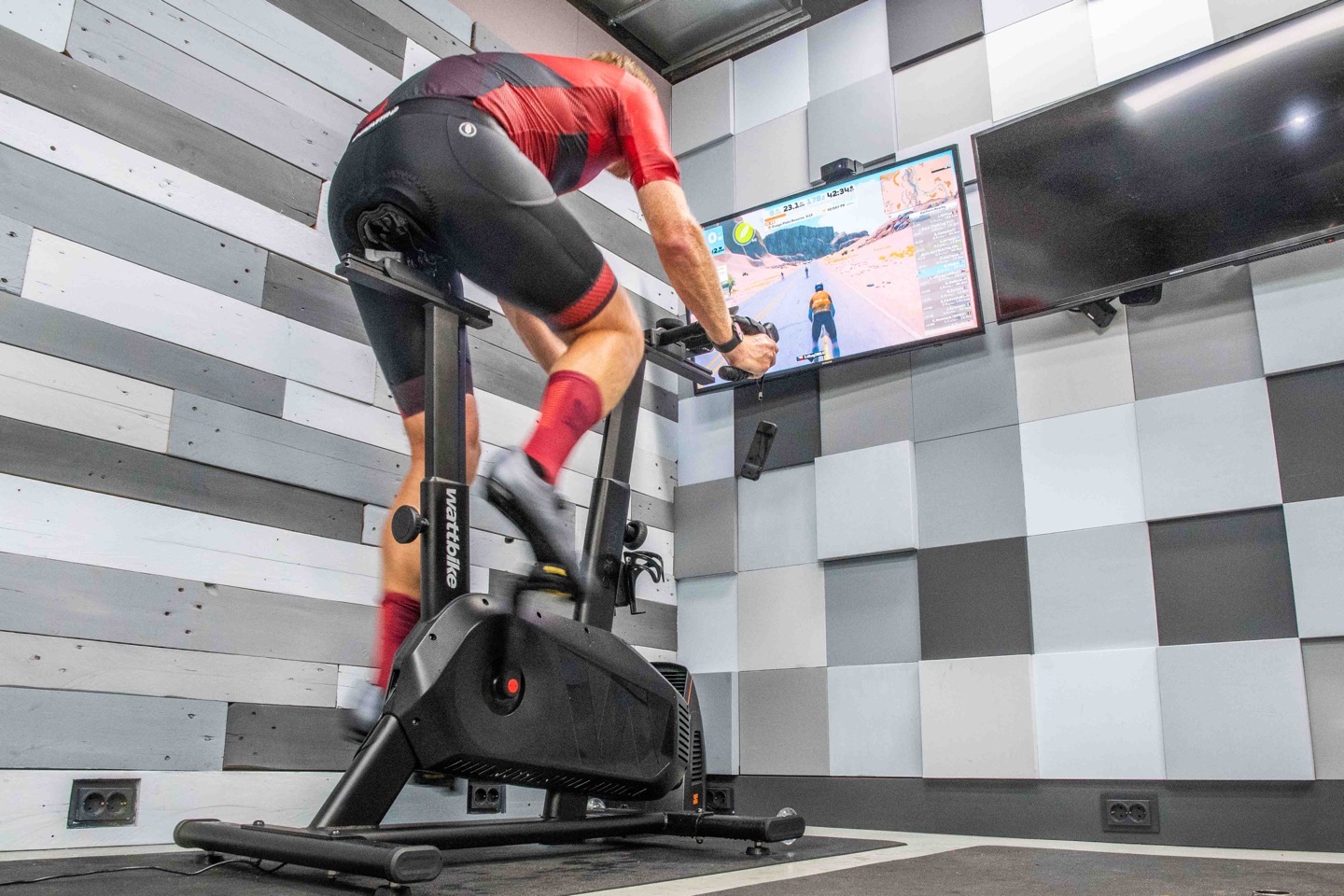
Wattbike has just announced what they’re billing as the beginnings of a refresh cycle for their entire indoor bike lineup, covering both end of their indoor bike range – including both electronically controlled bikes, and wind resistance bikes. However, as part of this effort, they’re introducing a new slightly more budget friendly option, the Wattbike Proton, which is aimed at a slightly different audience than the existing Wattbike ATOM series.
This new Proton unit is heavily focused on packing as much as it can into a smaller footprint, but still maintaining the exact same internal and electronic features as a Wattbike ATOM, except in fact, better internals. They’ve addressed a key pain point I noted in my Wattbike ATOM review: Slow responsiveness in ERG mode. That’s now solved via a hardware gearing change (more on that below).
However, Wattbike says that the Proton isn’t directly aimed at the serious Zwift racer, instead they recommend the Wattbike ATOM series for the best experience there. Instead, the Proton is really aimed at those considering a Peloton Bike, but don’t want the subscription aspects, or what better 3rd party compatibility (and when I say ‘better’, I mean, any at all – since the Peloton Bike is locked to Peloton). The Wattbike Proton is fully open, just like any other smart bike/trainer in the market. So you can connect any platform you want, or, use Wattbike’s own extensive library of free workouts, plans, and more. We’ll get into that down below.
With that, let’s dive into what’s new and different on the Wattbike Proton.
Key Specs & How it Differs:
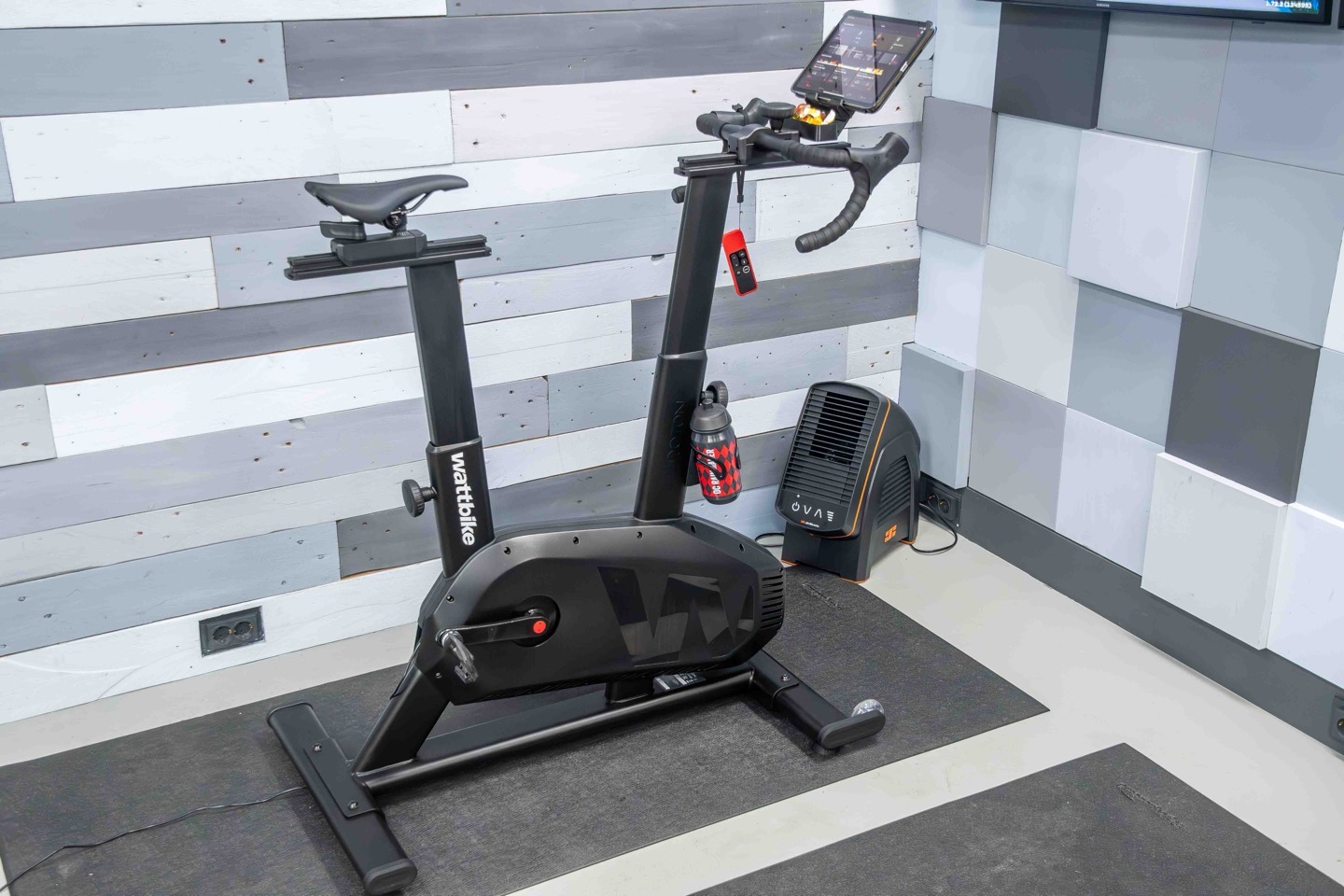
In many (most) ways, the key differences between the Proton and ATOM are really around bike structural design in terms of both bike fit, as well as size of the overall frame. The Proton was specifically designed to fit into markets (e.g. Japan) that have much smaller footprints in terms of available space. As such, it’s some 20cm shorter than the ATOM. Further, it has a wider fit range, enabling it to accommodate substantially shorter people, as well as taller people. And in fact, does away with any meaningful amount of step-over required (since it doesn’t have a top-tube).
Of course, inversely, you lose things like the aerobat-style bars on ATOM, as well as the general look of the ATOM. Here’s the key specs though from a smart trainer/bike perspective:
– Power Accuracy claim of +/- 1%
– Max 25% simulated incline (of resistance unit)
– Max 1,800w supported resistance
– Zero-calibration software algorithm
– Dual ANT+/Bluetooth Smart support, including ANT+ FE-C, plus power/speed/cadence broadcasting
– 170mm crank arms (non-adjustable)
– Q factor: 160mm
– Max rider weight: 135kg/297LBS
– Requires power cable/be plugged in
– Weighs 48kg/105lbs (but has wheels to roll round)
– Pricing: £1,795/$2,499USD/AU$3,749 (with US/Australia availability in early 2025)
The ATOM and Proton both use the same internal electronic resistance system, however, with one notable change. The gear ratio of the Proton has been changed from 18:1 on the ATOM, to 13:1 on the Proton. This results in a much more steady ERG mode holding of power (previously on ATOM, it wobbled quite a bit). I haven’t noticed any downsides to that in my testing.
Now, the 3rd product is their ‘Air’ lineup, which is also refreshed. I haven’t reviewed that previously, as it tends to be more focused on gyms and other commercial settings. For fun, here’s a comparison chart that Wattbike has, that shows the difference between the three models. Note that at this time, the ATOM isn’t getting a major refresh. Instead, this first phase is really about the new Proton and Air getting big refresh.
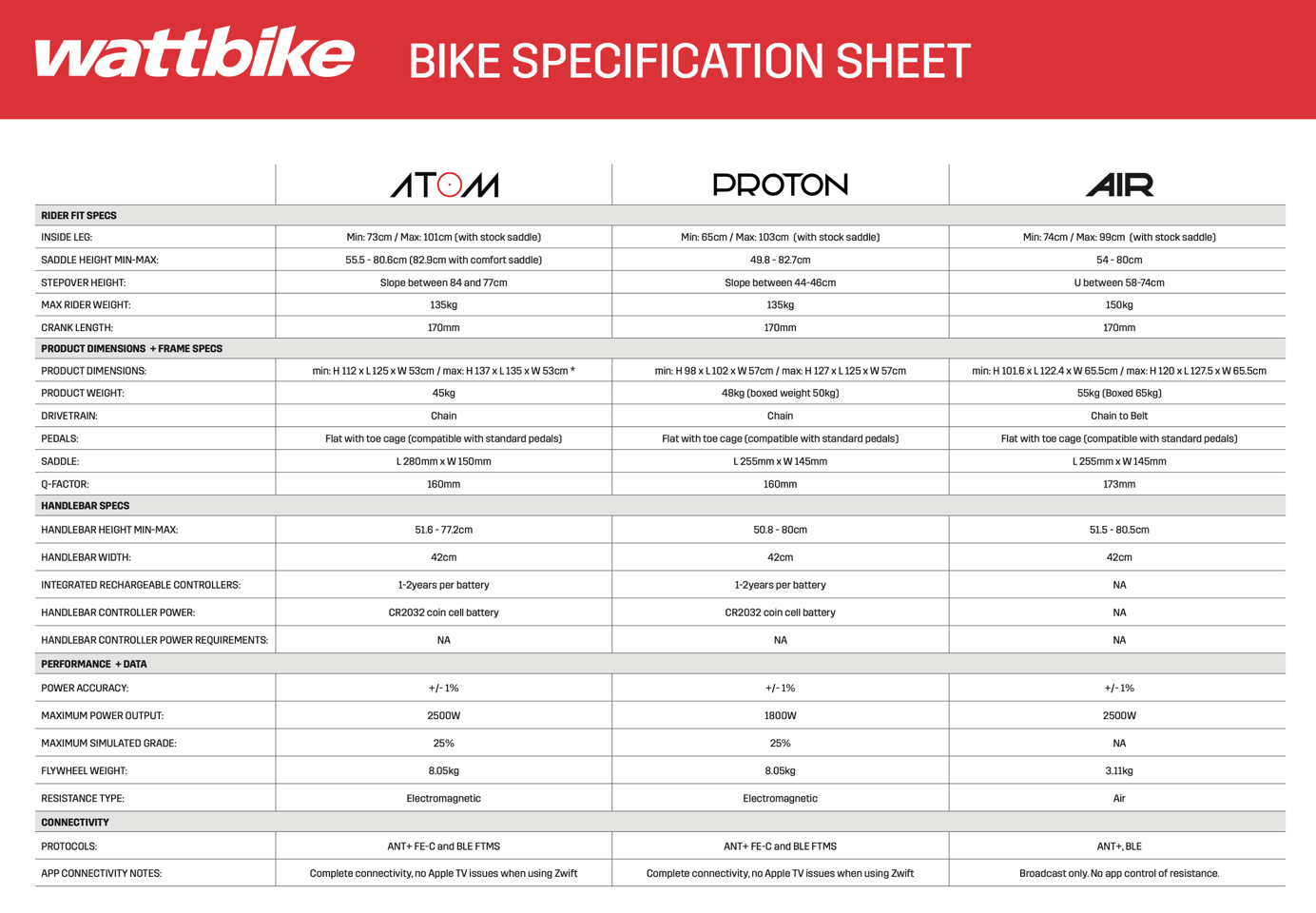
With that, let’s dive into using it.
The Proton Hardware:
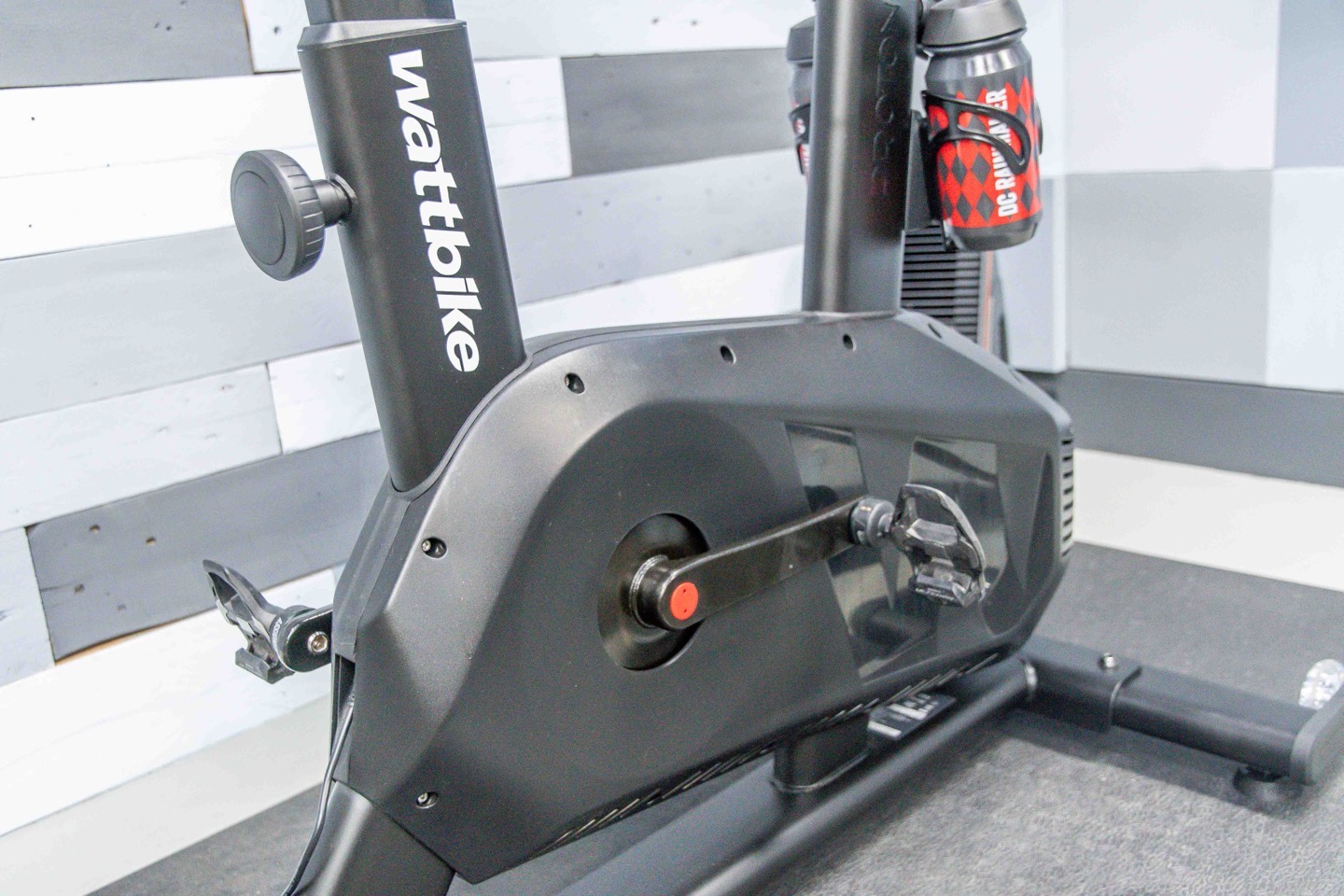
One of the main reasons you’d get an indoor bike, over just putting a bike on a smart trainer, is for multi-user scenarios. Meaning, you can just the fit of the bike for different riders. The Wattbike Proton has a user height range of 4’6” (137cm) to 6’6” (198cm), though, for cycling, that’s really only one of the applicable metrics. You’re typically looking at inseam length, which would impact bits like stepover height and such. But the Proton sidesteps that by getting rid of the top tube, so there’s no meaningful stepover length.
So, let’s look at all the adjustably points on the bike. Though, two quick practical notes first. In order to have control and data transmission it does require being plugged into a power outlet, that power plug is on the back:
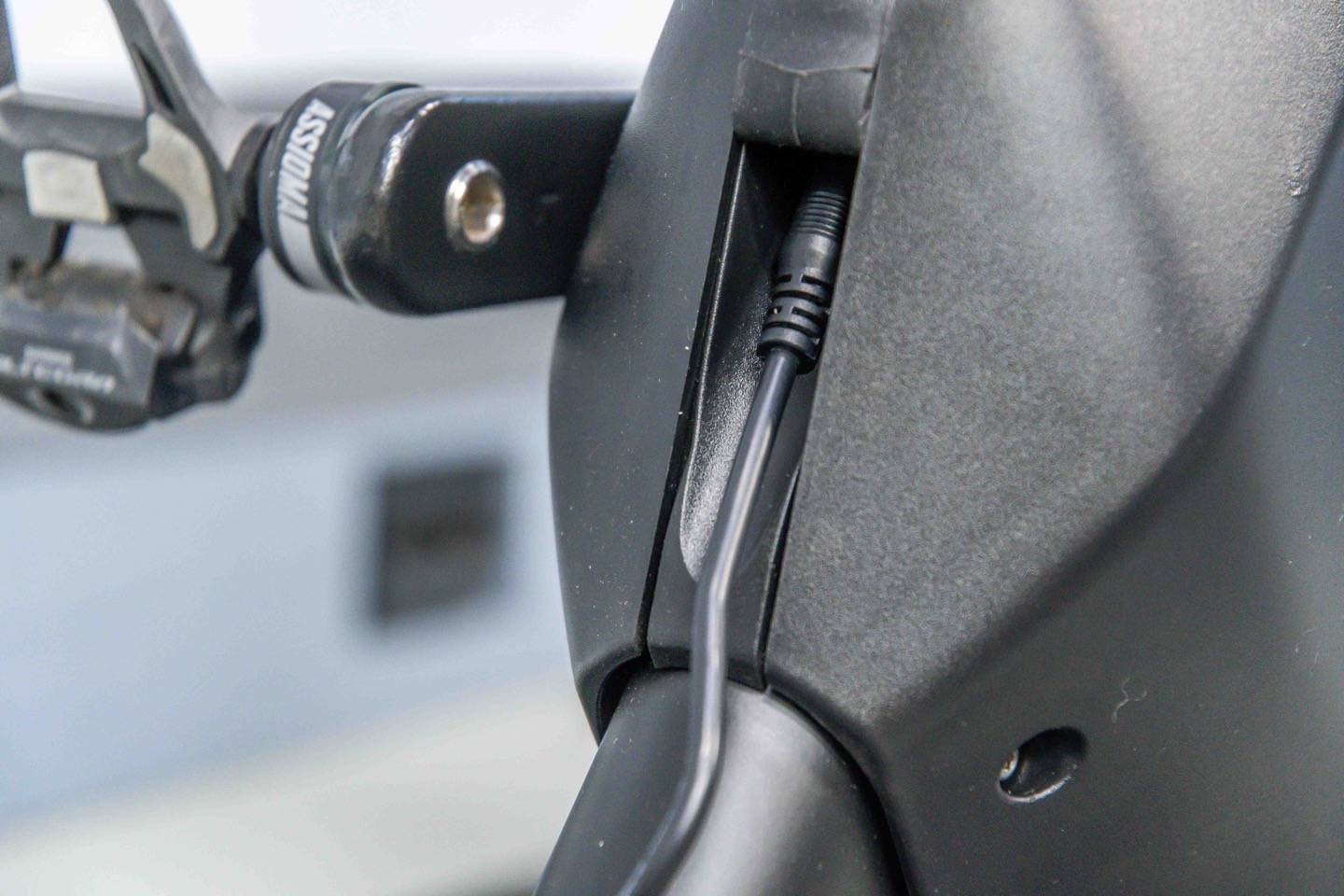
Meanwhile, up front are two wheels, that allow for easy movement around your home. I mean, unless steps are involved. In which case, then it’s slightly more adventurous. Albeit, I suppose going down the steps is easy. Whether or not it’s usable after the down-step journey is a different question.
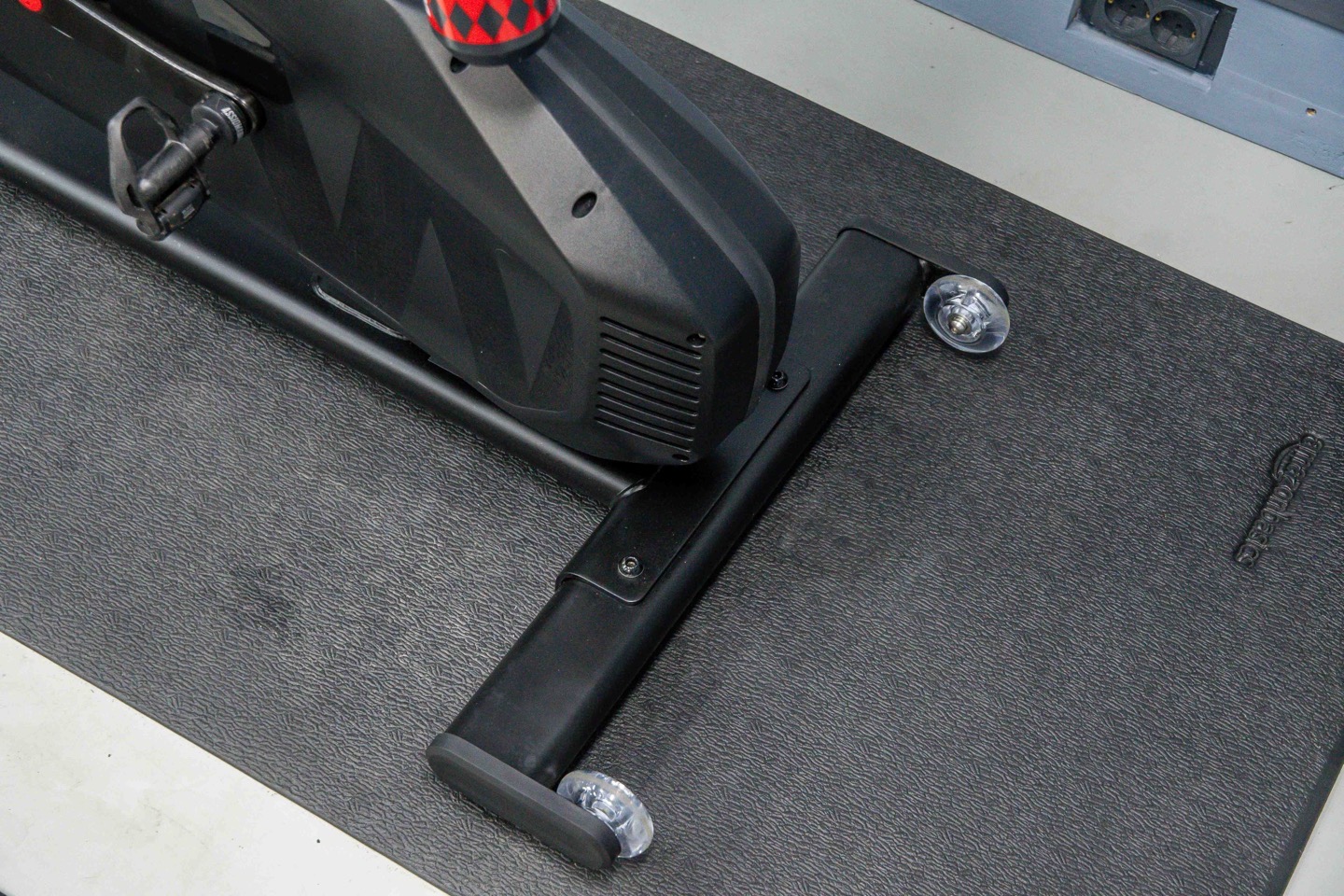
In any event, the Proton touts ‘tool-less’ adjustment for all things that you might need to adjust between riders. That’s a bit of a subtle dig at Zwift and the Zwift Ride, which requires a small wrench to make adjustments. Of course, it’s a 3-5 second thing to make adjustments there, but still, it’s one more thing.
Starting with the back of the Proton, there’s the seat post height adjustment. Simply rotate it to loosen it. I had zero issues with seat post slip (something I did see on earlier editions of the Wattbike ATOM, but was subsequently fixed).
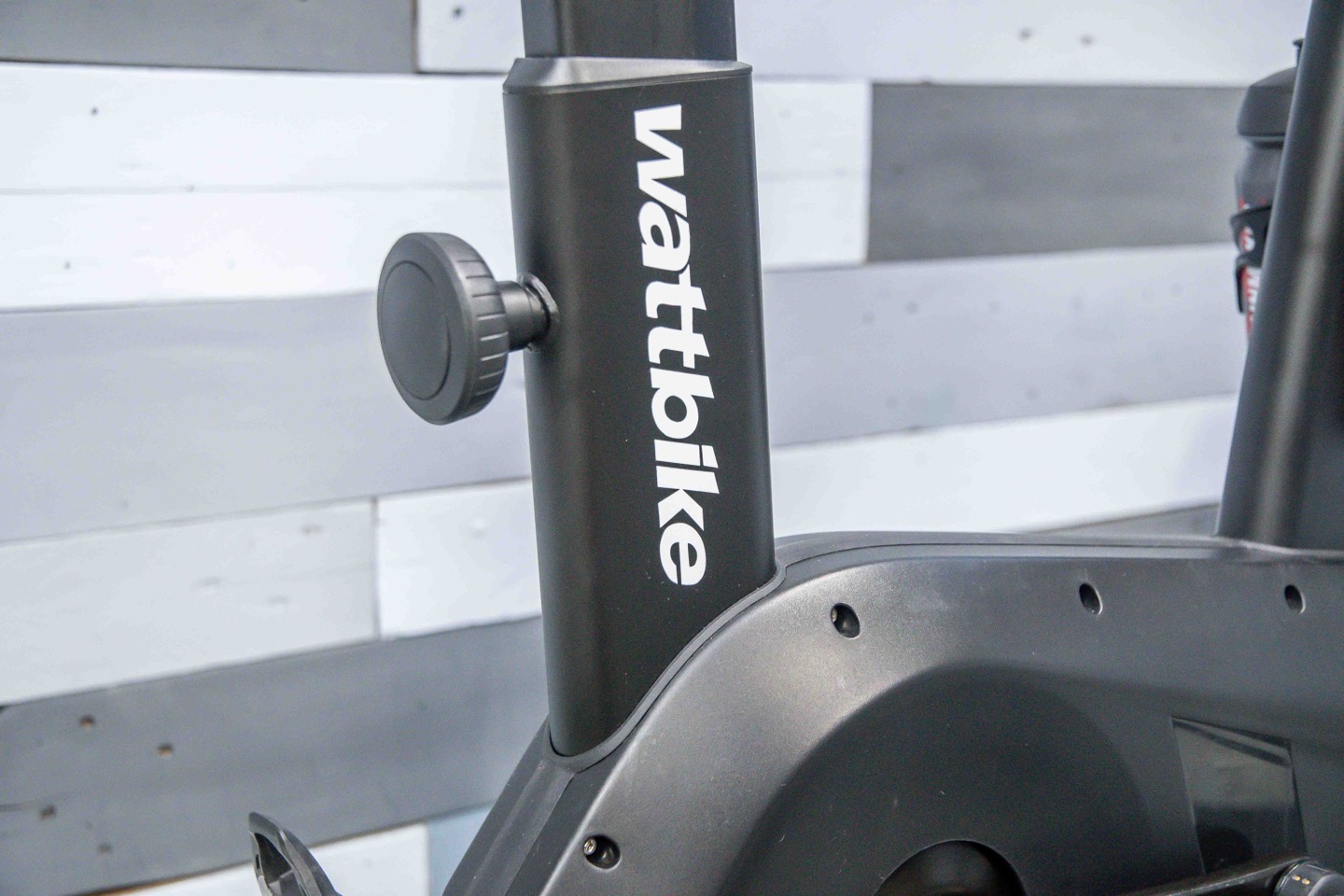
Next, there’s the forward/back movement of the entire seat on these rails. Again, this is tool-less with the lever you see there.

Both the seat post and saddle rail system have centimeter/millimeter markers on them, so you can quickly and easily get to the exact same place each time.
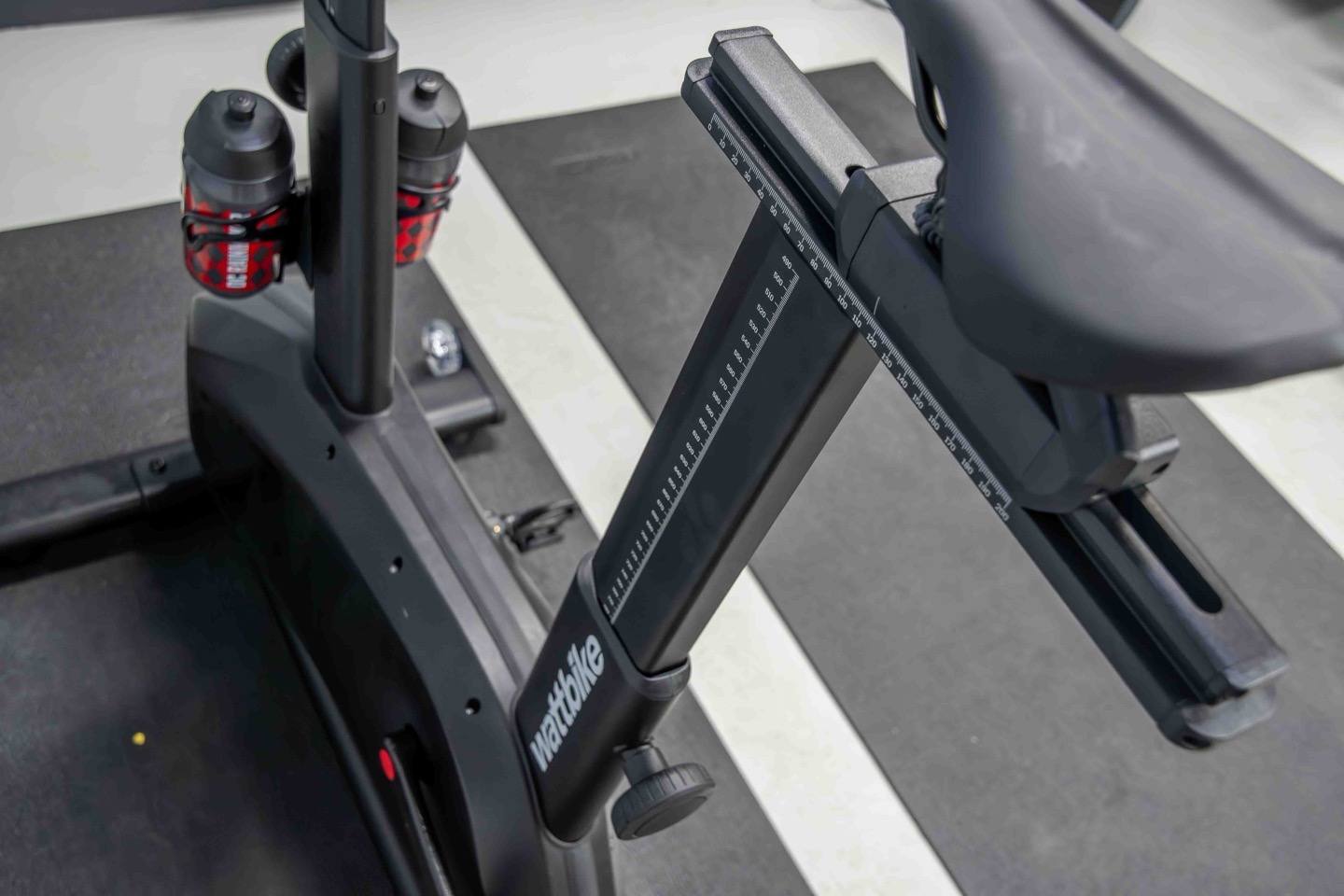
On the saddle itself, it uses a standard saddle rail system up top, though, a slightly tweaked one to attach to their moving rail down below. That means you can easily attach your own saddle, if you don’t like the one included. I will note that I couldn’t figure out for my first few rides why my thighs were lightly touching the rail on one side (and only one side), given the whole point of getting rid of a top-tube design is to avoid any sort of thigh rub issues. It wasn’t until I went to take these pictures that I realized the factory had set the saddle as slightly off-set from the rail (right photo below). This is a 2-3 minute fix with a wrench to re-align, but, just FYI in case anyone else has this happen, no biggie to fix (and I’m sure after I post about this, Wattbike will be adding a checklist item to their manufacturing).
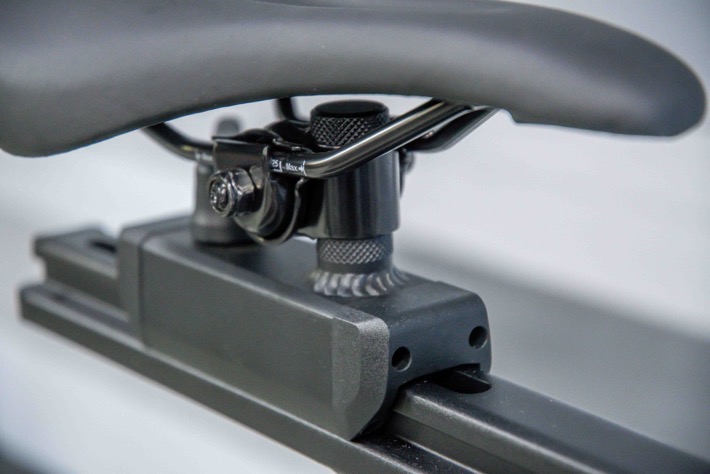

In any event, moving up to the handlebar assembly, you’ll see the large round knob for sliding the entire assembly front/back. While I think the knob looks a bit ugly from a design standpoint, it is very easy and functional to use. I suppose sorta like risotto, takes great, but photographs horribly. You’ll also note all the fit markers.
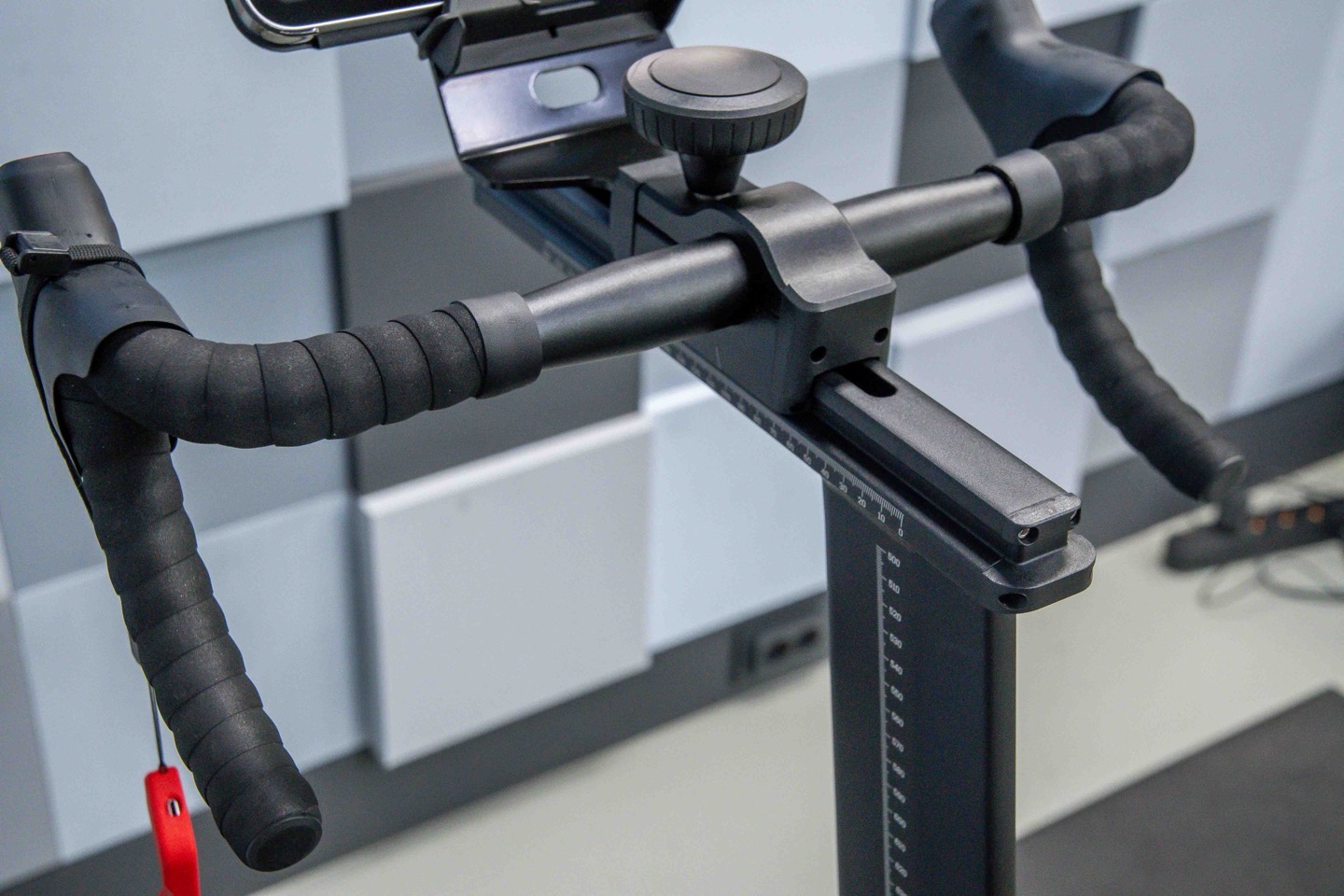
The same is true for the entire handlebar assembly going up/down. There’s a knob down near/in-between the water bottle cages. Exactly like the rear knob, except, a front knob. Which, probably sounds bad when written out like that.
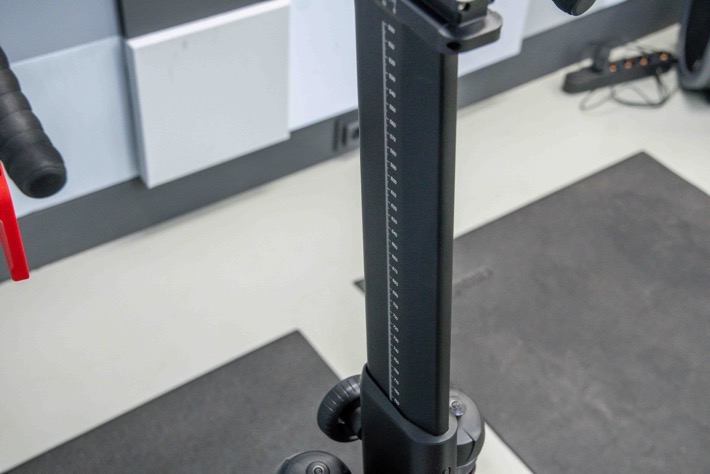
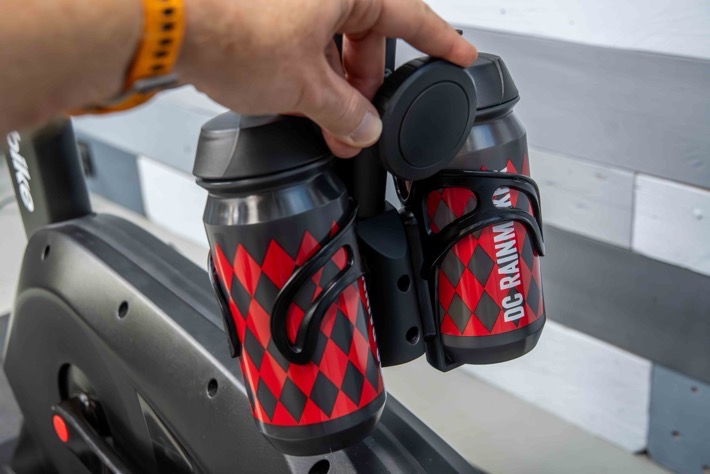
Meanwhile, up front there’s a tablet/phone holder: You just slide your phone into the grooves, and it’s nice and wide to support iPads/etc… without any issues
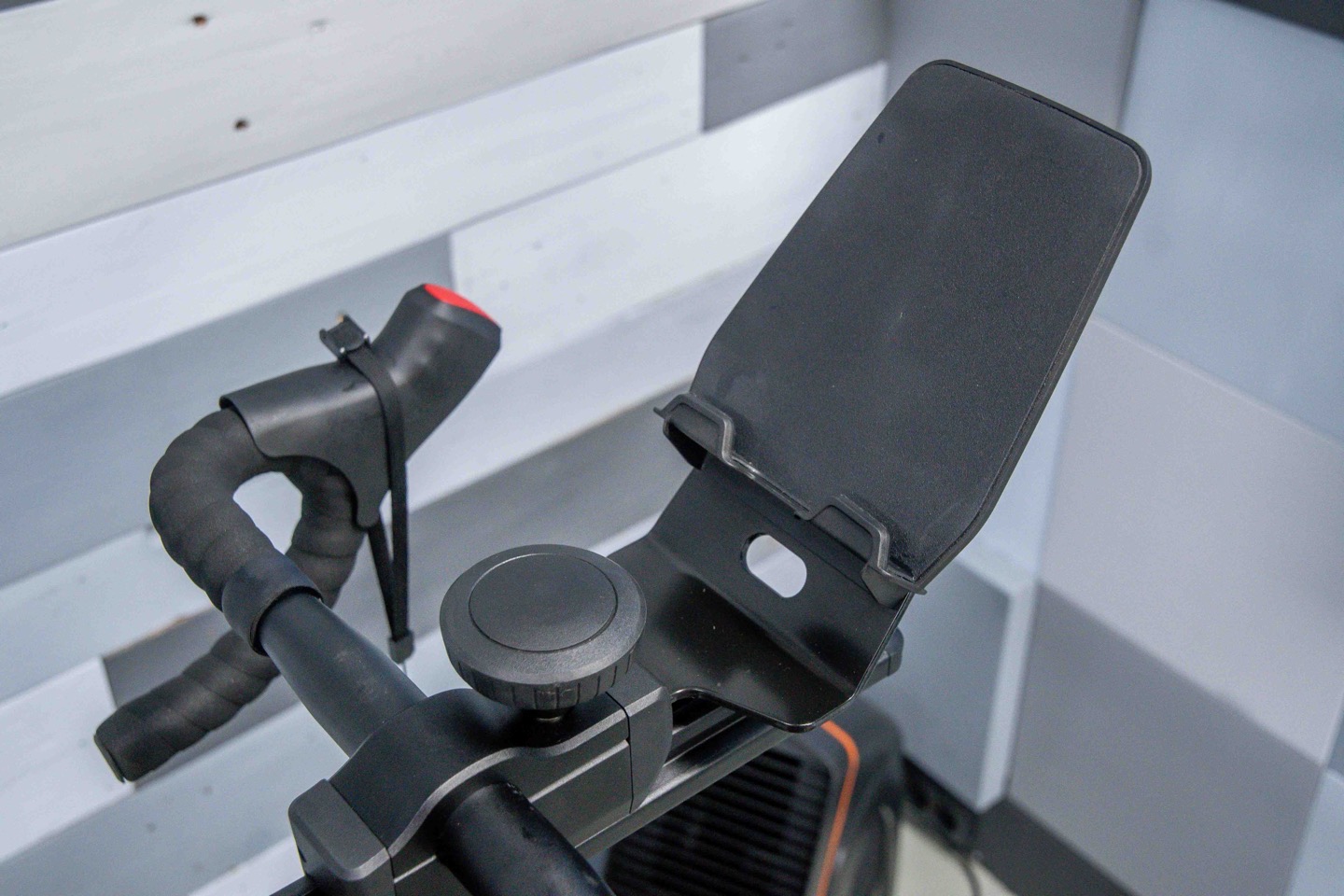
You can see here it holding the iPad Pro, and an iPhone.
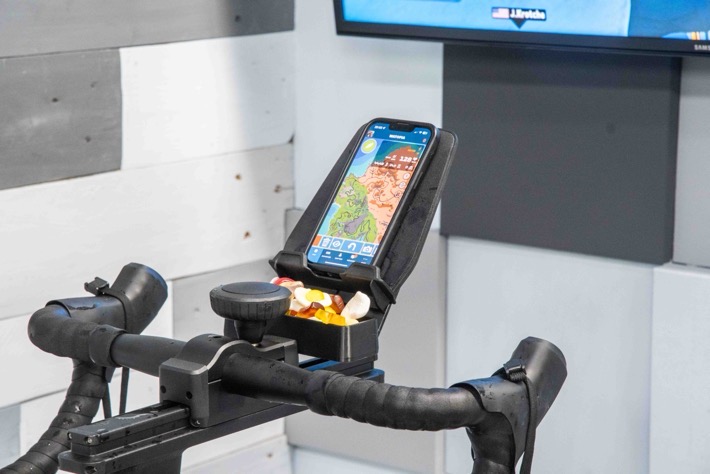

At this juncture, the astute of you may have noticed an additional accessory: The Haribo Holder.
This accessory is custom-designed to slot directly into the space between the tablet holder and the adjustment knob, and holds approximately one-half standard size bag of Haribo Star Mix. It’s not compatible with the entire contents of the Jumbo Bag size in a single sitting, which means that you’ll get two training sessions out of the bag (or, will require a mid-ride refuel).
The tray detaches for easy cleaning, in the event that you put other unsupported products in there, resulting food failure (e.g melted chocolate, or truffle-coated bon bons).
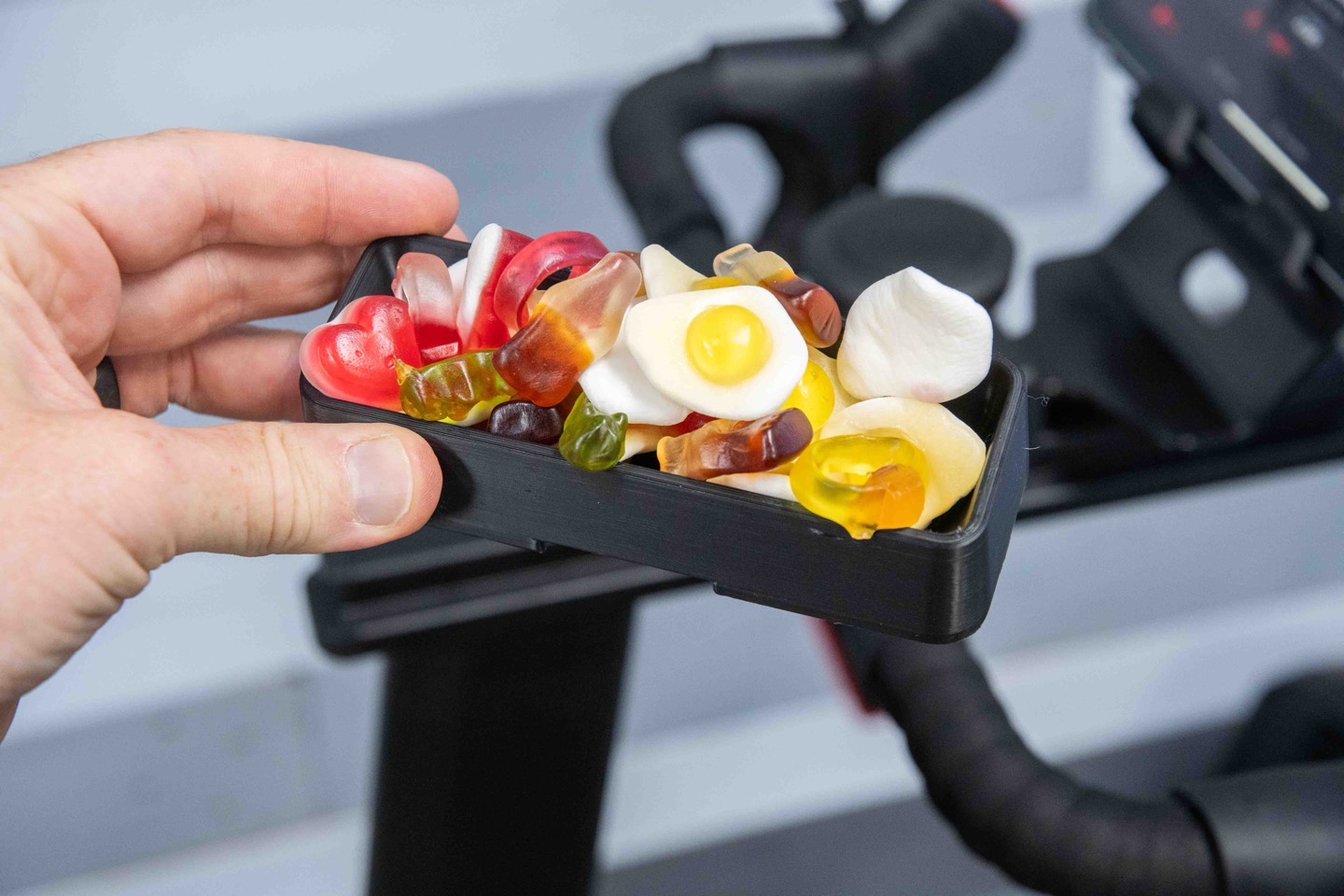
Now unfortunately, I’m told this Haribo Holder is not standard issue on all Wattbike Proton units. Instead, it’ll require you have a 3D printer, to print the little tray. Ideally Wattbike will release that 3D printing file shortly, enabling Haribo holding for all.
In any case, back on the bike technical bits, the one minor downside is there’s no USB power ports up there, so, you’ll just have to have some cables hanging down. Same goes for any place to hold remote controls. In my case, my Apple TV remote controls I’ve bought little/cheap cases/leashes for them, but I’m still a long-time fan of places to stash things on indoor bikes.
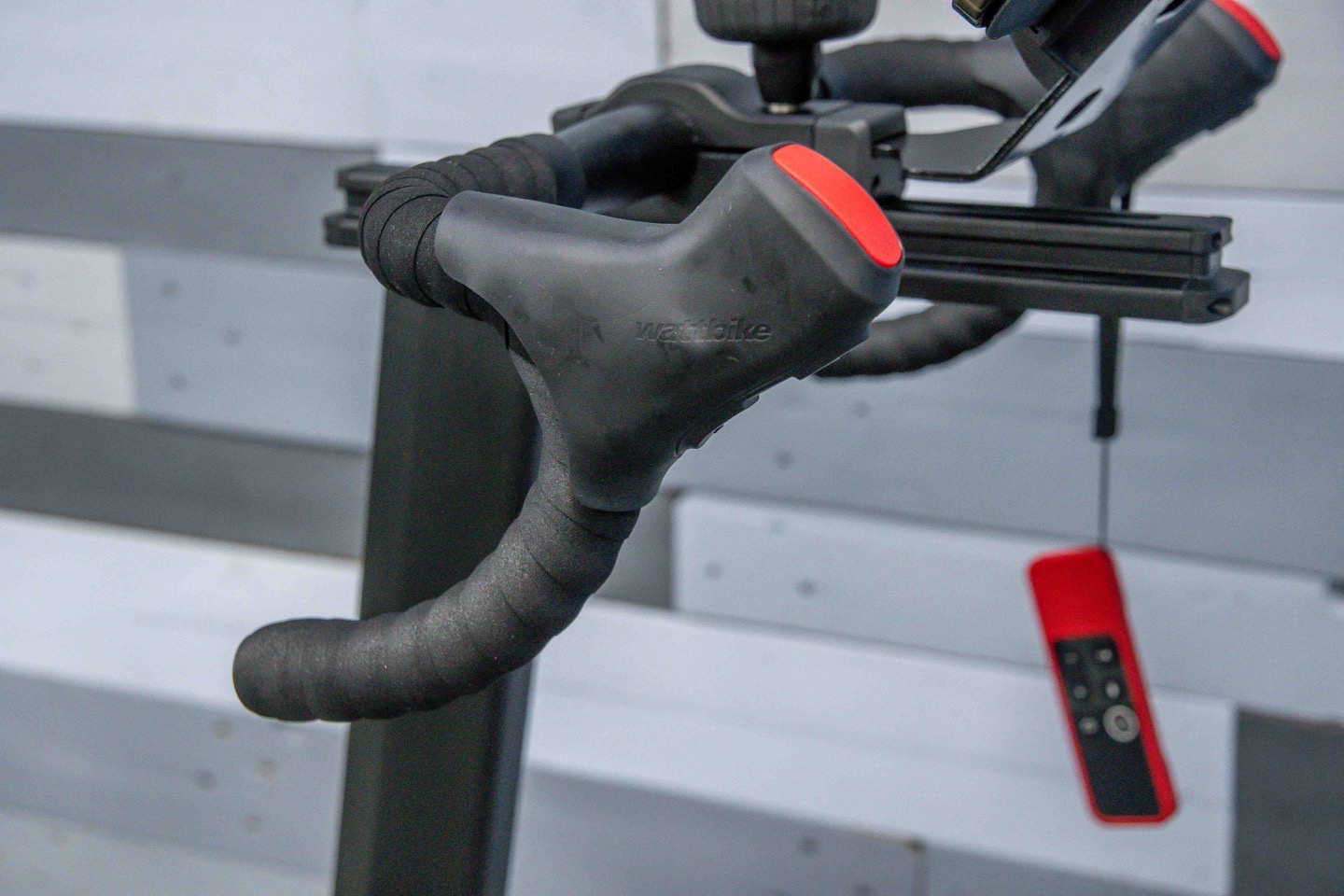
Now, looking closely at the handlebars above/below, you’ll see some buttons. The red bits on top are the action buttons, and then down below that on the front are two more buttons, which are primary shifters. These will vary based on the app. For example in the Wattbike Hub app, these buttons have more functions. Whereas in Zwift, it’s really on the right lower buttons, which shift easier/harder.
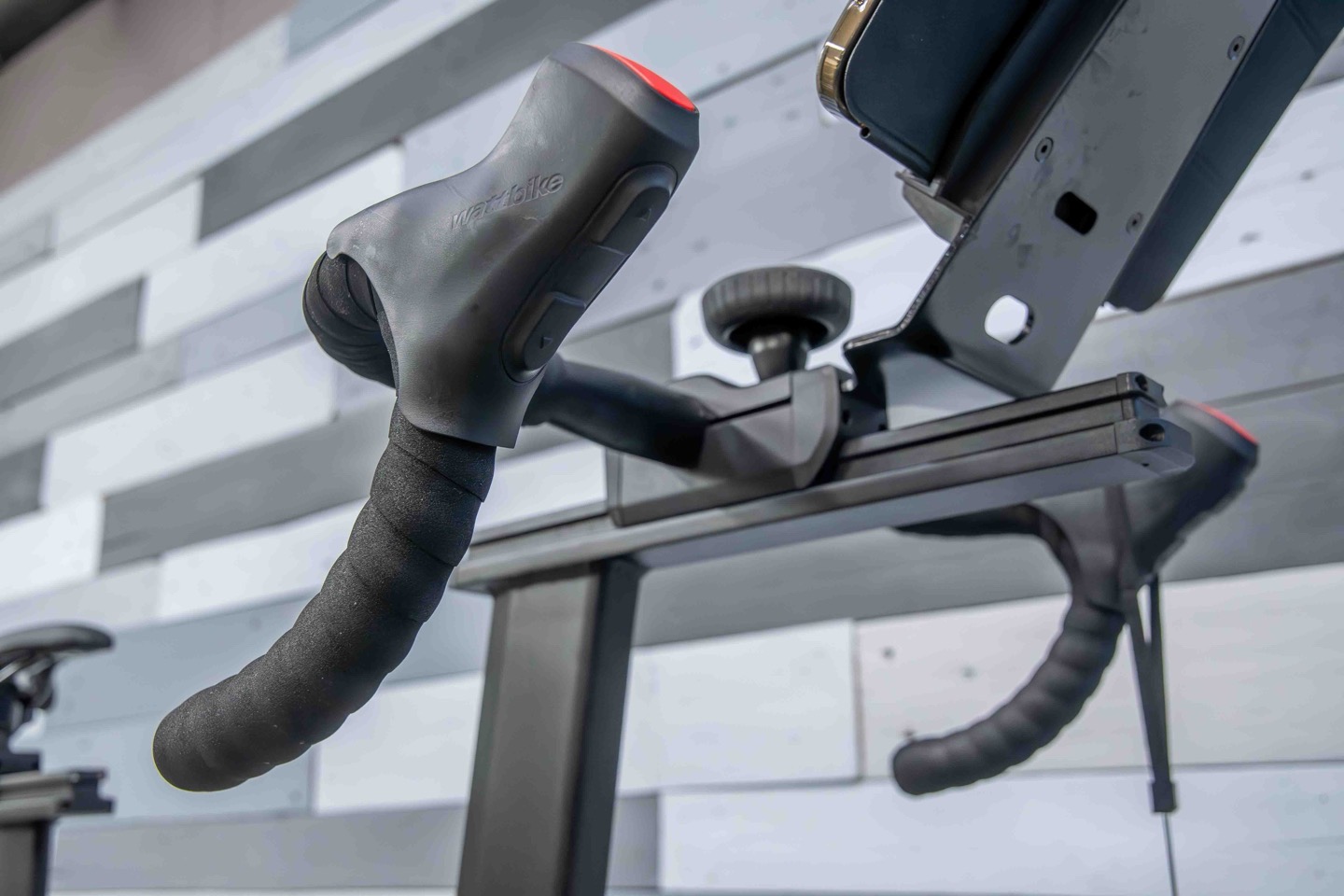
Shifting responsiveness, be it in Zwift or other apps is quick and…well…responsive. I have no issues with how fast the shifting is. Sure, it lacks a click sensation of more realistic shifters like those found on the Wahoo KICKR Bike/SHIFT, but it works just fine.
When it comes to pedals, the bike supports any standard pedal attachment. In my case, I swapped out to my own pedals, but, if you’re more of an exerciser type, then it includes such pedals in the box:

In terms of sound, the unit products a bit of sound, mostly a low-level whirring sound, that’s a bit less than a fan. It’s not silent like a Peloton Bike, for sure, but it’s also not horrible either. Note that there’s no meaningful difference between steady-state and sprinting (high-speed), since it’s just an internal resistance change, and not an actual gearing change.
Wattbike Hub App:
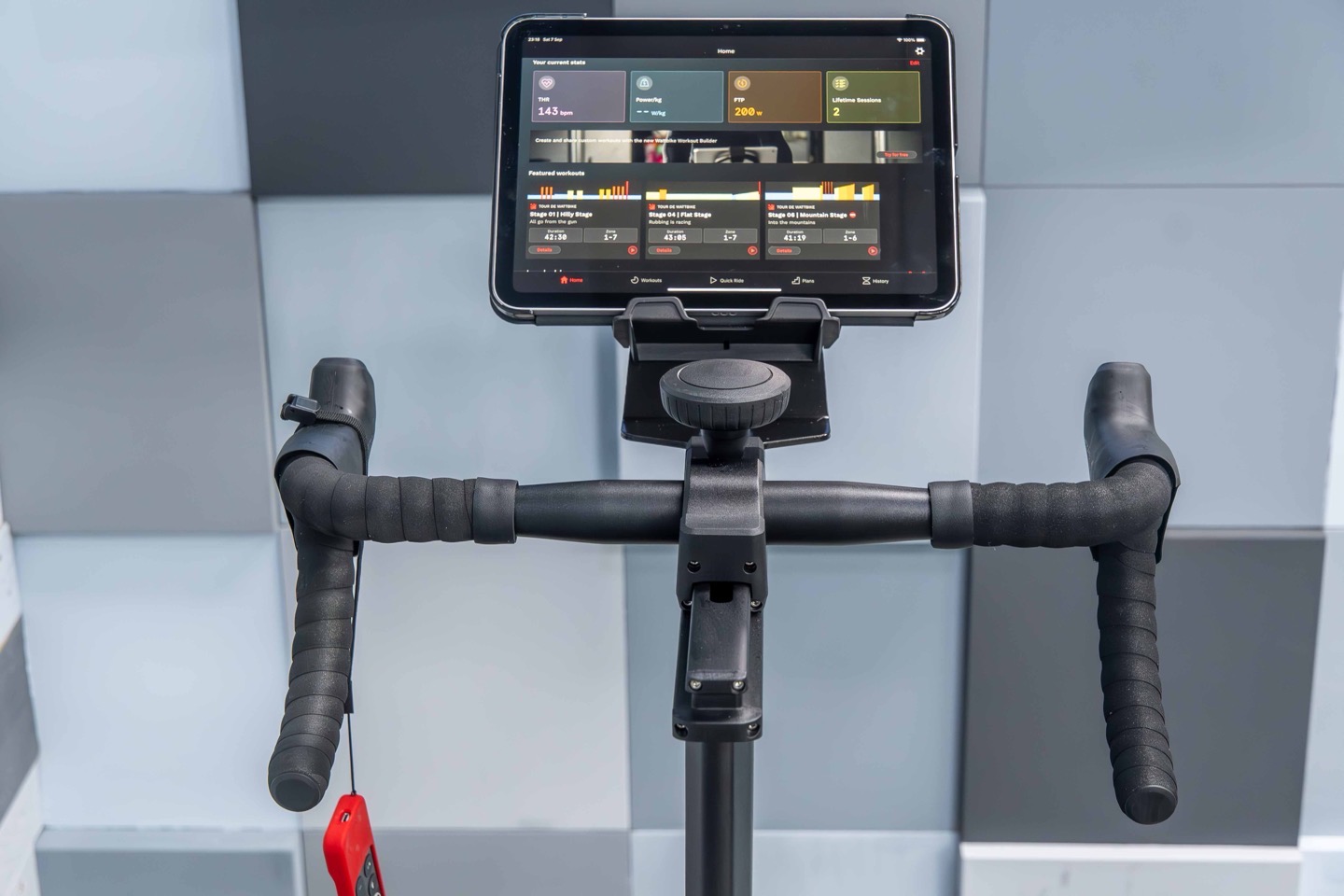
If one were comparing Proton to the Peloton Bike, likely the big standout difference is that Peloton effectively requires a subscription to Peloton, whereas Proton doesn’t require any subscription to anything. Yet concurrently, Proton works with everything (whereas the Peloton Bike isn’t compatible with any other apps). Further, Proton includes a bunch of workouts and training plans and such within the Wattbike Hub app for free, more than enough to keep you busy. Of course, Wattbike also has Wattbike Hub+, which has a few extra features in the app as a paid subscription if you want it, but honestly, the base free version has boatloads in it.
So, starting with that piece, here’s the free/base Wattbike Hub app. For example, there are a slate of workouts categorized into different buckets, based on either focus area or duration. The screenshot at the below right is just showing a few of teh many workouts in the “30 minutes to spare” bucket.
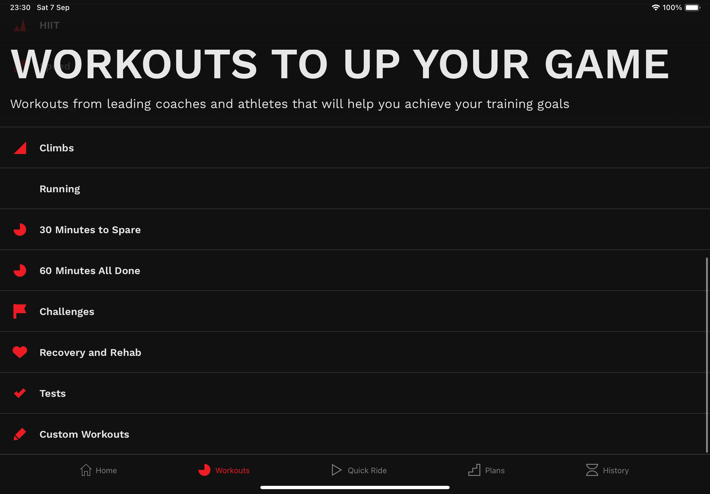
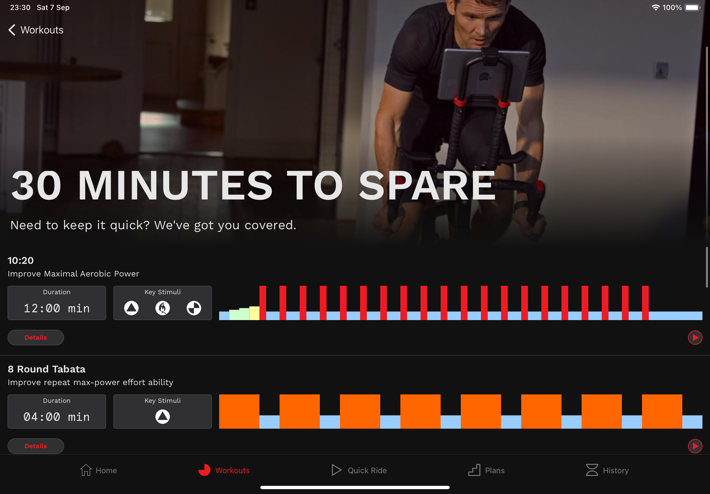
Same goes for the other buckets, like those with an hour to burn.

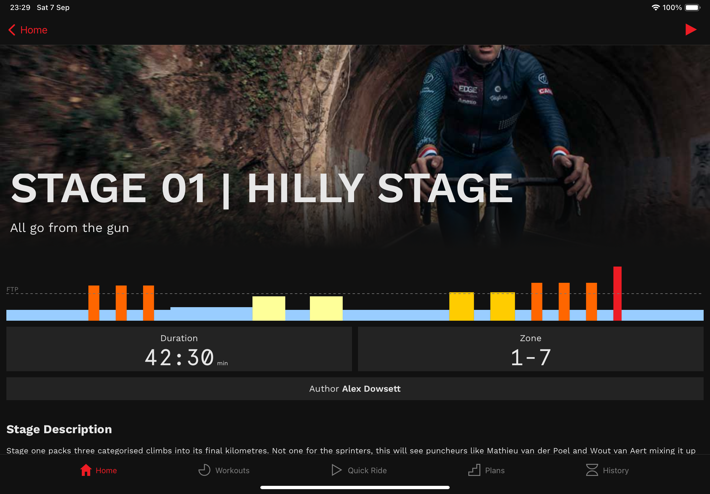
But there’s also a ton of free training plans too. Very few companies actually offer totally free training plans, especially in the indoor cycling space. We see some watch/bike computer companies offer such things (e.g. Garmin or COROS), but most other indoor trainer training plans require some sort of subscription platform.


Again, these are all categorized, such as these sportive training plans, and then each stage has details about what exactly you’re doing.


Or this 100 Mile Ride plan, which also lists out each week all of the workouts you’ll do, with the exact structured workout that it’s going to leverage.

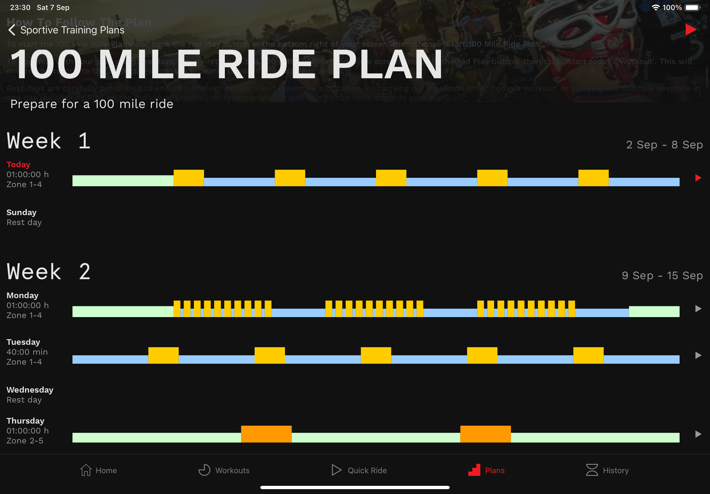
And then for any given structure workout, again, it’ll list all of the structural details of the workout, as well as *why* you’re doing that particular workout.
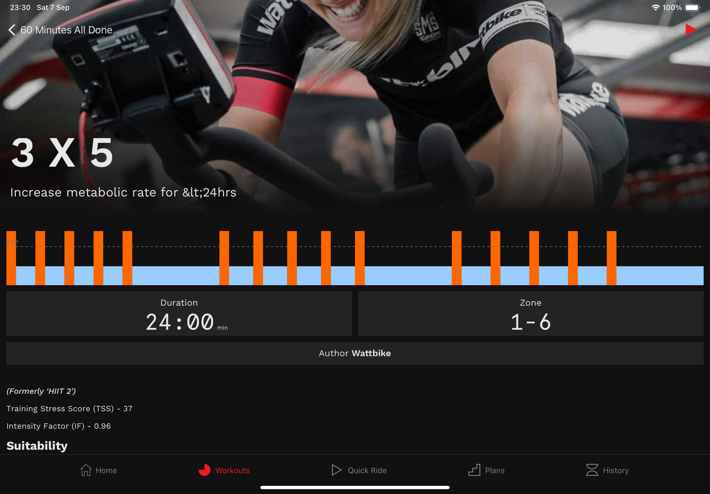
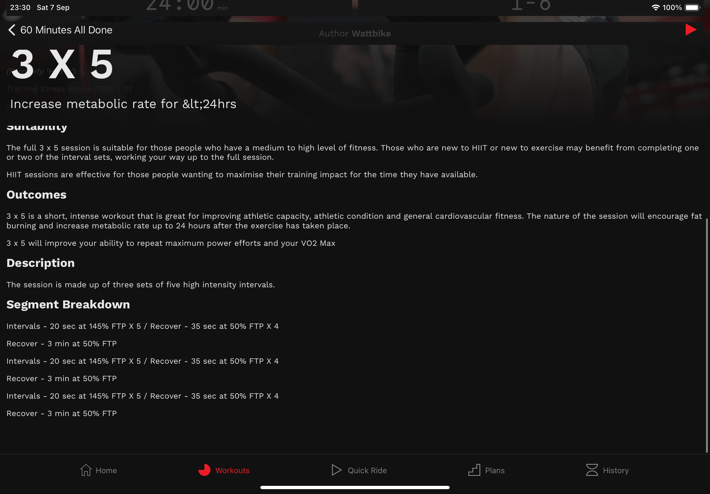
In addition to this, there’s also a more generic ERG mode that you can use, that’ll basically just let you control the Wattbike Proton on the fly. This also has the famed ‘peanut’, which shows your overall stroke and exactly where in the pedal stroke your power output is coming from. This hails back from the CompuTrainer days (or at least, that’s the first time I ever saw it), and is often shown by companies to demonstrate that they have higher-speed data coming from the pedals/resistance unit. That said, in practice, I don’t know how many people actually get much long-term gain from using this.
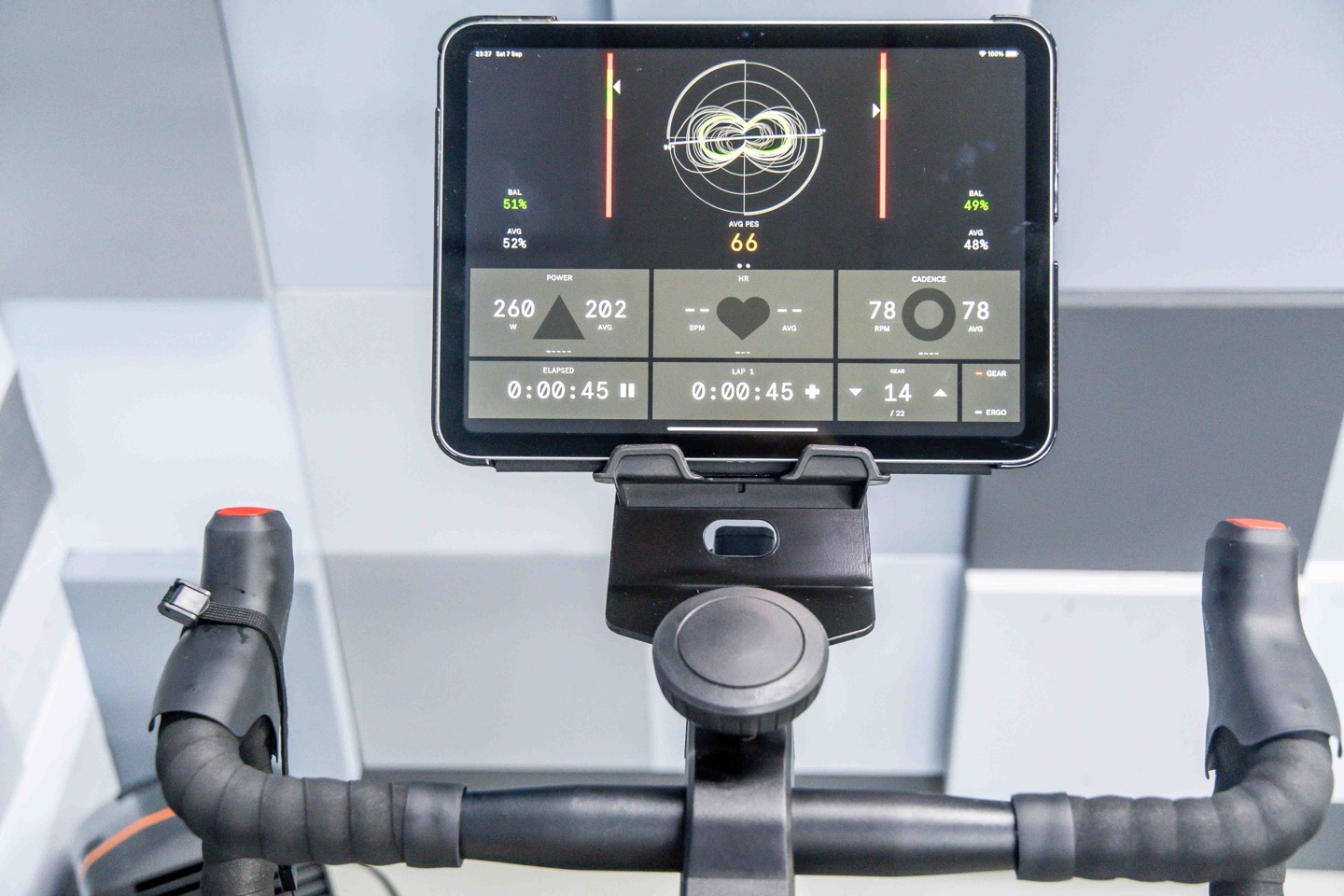
It should be noted that in their own app, the buttons on the Wattbike come alive a bit more. The right buttons will increase/decrease ERG levels (intensity), while the left buttons will change data screens on the app.
And again, there’s also the paid version, which adds a custom workout builder and a few more features. That’s all outlined in this FAQ there. But everything I’ve shown above is in the free version.
3rd Party Apps:
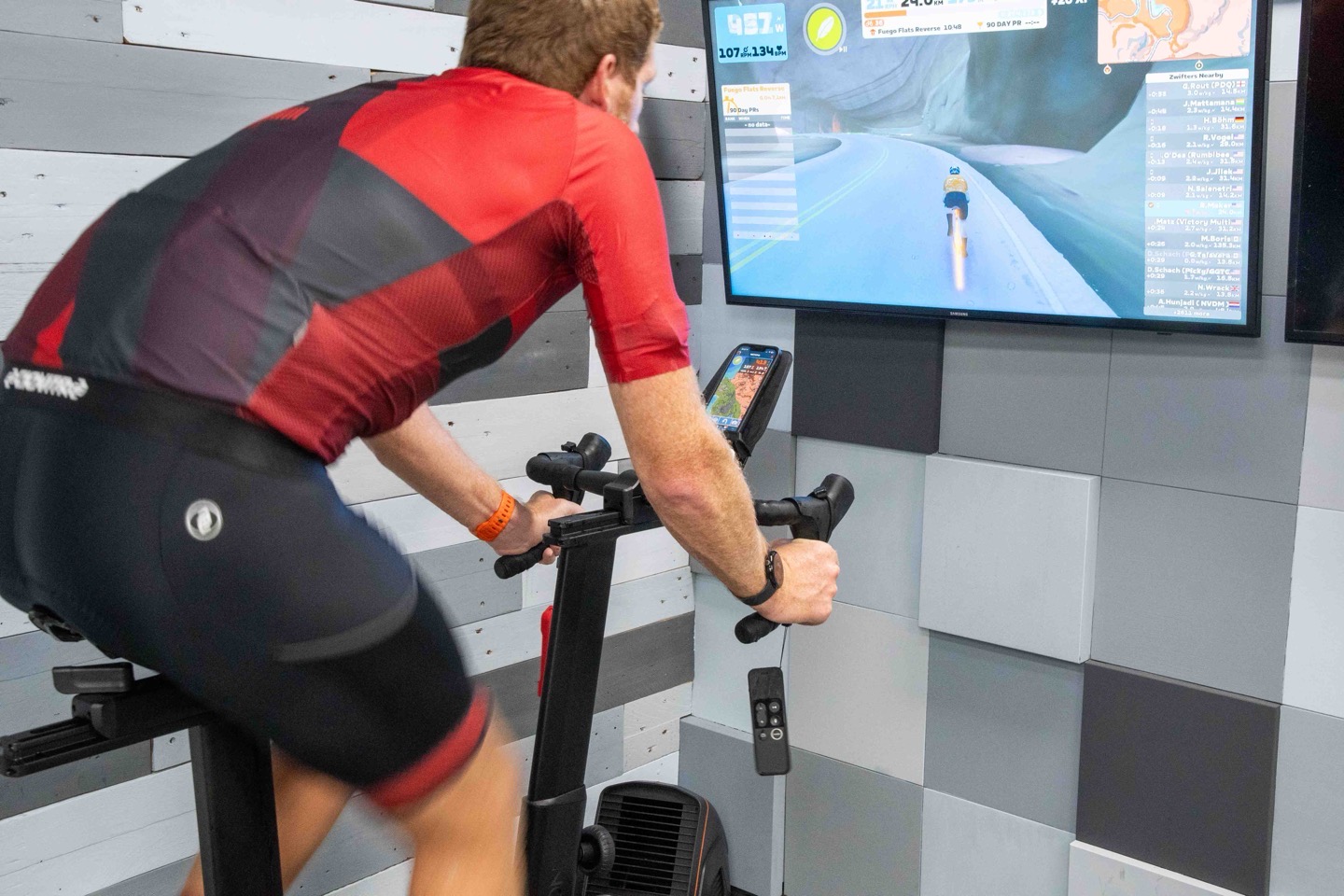
Now as I mentioned in the previous section, Wattbike leverages all of the open standards to allow any 3rd party app to communicate with it. This means it’s communicating over both ANT+ & Bluetooth Smart. It has dual Bluetooth Smart concurrent connections as well, meaning that it can connect to both 3rd party apps like Zwift at the same time as the Wattbike Hub app (to show current gearing on the Wattbike Hub app).
From a protocol standpoint it supports, specifically:
ANT+ FE-C (Trainer Control): This is for controlling the trainer via ANT+ from apps and head units. Read tons about it here. This also includes speed.
ANT+ Power Meter Profile: This broadcasts as a standard ANT+ power meter, with cadence data as well
Bluetooth Smart FTMS (Trainer Control): This allows apps to control the Wattbike Proton over Bluetooth Smart (with cadence/power data)
Bluetooth Smart Power Meter Profile: This broadcasts as a standard BLE power meter with cadence
This means that just about every app out there can connect to it and control it. Remember, there are two pieces to a smart indoor tranier/bike. The first is displaying the data coming from the bike, while the second is controlling the bike. It’s this second piece that’s important, as it allows you to run structured workouts (aka ERG mode), or to simulate gradient changes like a real road outside (aka SIM mode).
In my testing, I used Zwift as a 3rd party app for both of these. Though, I’ve also used plenty of other 3rd party apps with other Wattbike units in the past, such as TrainerRoad, Kinomap, Rouvy, and more. All of these leverage the exact same ANT+ FE-C and Bluetooth Smart FMTS controls. In fact, so do bike computers like those from Garmin, Wahoo, and Hammerhead. More on the in a second.
First, looking at the pairing process within Zwift, you’ll see the Wattbike Proton show up as both a power source as well as a resistance controllable unit. Plus of course, also also showing cadence.

But what you won’t see is it showing up as supporting Zwift steering (like a Wahoo KICKR Bike or Zwift Ride). I don’t think that’s a huge deal for many people, and honestly, if you’re into that, then adding the Zwift Play controllers to the handlebars is frankly a far better option, as it gives you many more Zwift-specific features.
Once in Zwift, it’ll follow the gradient just as you’d expect from any other smart trainer. I found the responsiveness plenty good for both gradient changes, as well as sprinting and such. Here you can see me wandering through some rollers. That said, you’ll notice the Zwift app isn’t showing the current Wattbike virtual gearing in the upper left corner (usually it’s below the blue block of text).

In asking Wattbike, they noted that it was working just fine until very recently, but has randomly stopped in recent weeks. They’ve reached out to Zwift to find out why. It may be tied up in Zwift’s transition to the Zwift Protocol, which Wattbike says it’s eager to support. Either way, Zwift has an absurdly long relationship with the gearing indicator appearing and disappearing for all indoor bike brands at random times without notice to users or companies. If there were a single technical item that best encapsulated the often frustrating and non-communicative relationship between Zwift and indoor hardware manufacturers, it’s probably the virtual gearing display.
In any case, I didn’t find it a show-stopper, just more of a “Sigh…it’s gone again.” thing.
Meanwhile, for ERG mode workouts (structured workouts), you wouldn’t see that virtue gearing indicator anyway, since there’s no need for shifting in any structured workouts. I had no issues here from a Zwift/control standpoint. And in the accuracy section, I dive into how that handles from a stability perspective.
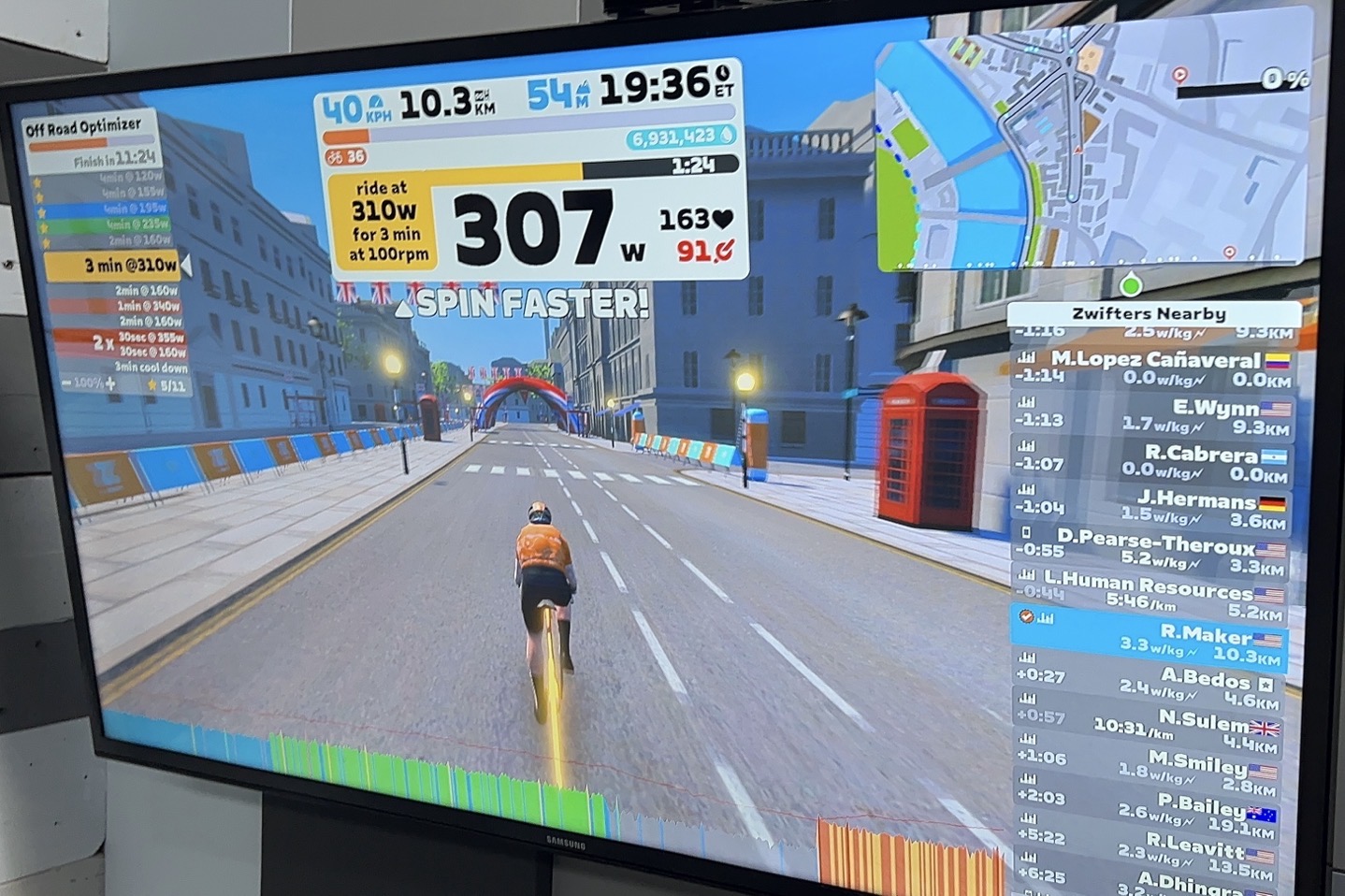
Again, all of that worked just fine for me, as expected.
Finally, you an also connect your watch/bike computer to the Wattbike Proton. This is super useful if you’ve got an endurance sports-focused watch that looks at training load and leverages the power meter values. For example, a Garmin/Suunto/COROS/Polar watch (Apple connects too, but doesn’t use power data in its training load calculations).
Taking Garmin as an example, here’s it connected to a Garmin Fenix 8, showing the power meter, as well as left/right balance information and cadence (RPM):
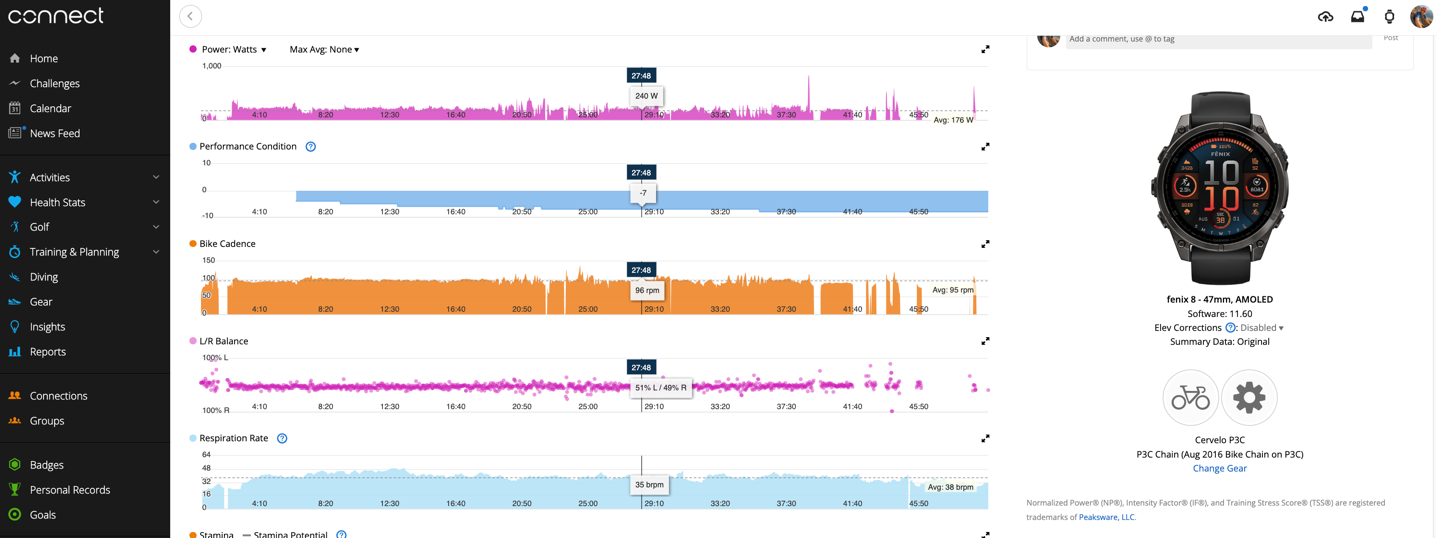
Again, all of this is pretty normal stuff for companies that follow ANT+ & Bluetooth Smart standards, which, is every company except Peloton. But the point being, if you were trying to do this with a Peloton Bike, you can’t. For some people, that might not matter at all (many of my friends just wanting go to focus on general fitness), whereas for others it matters very much (many of my friends that are in the endurance sports realm). To each their own.
Power Accuracy:

Historically speaking, we’ve seen reasonably good power accuracy from the Wattbike ATOM, and this unit is using the same electronic motor as the Wattbike ATOM, except just with slightly different internal gearing. The point of that gearing change was to address one key issue with the ATOM: Instability in ERG mode. This meant that when you did an ERG mode on the ATOM, it wouldn’t hold the set point well (e.g. instead of holding 250w per the prescribed workout, it would wobble a bunch). By changing the internal gearing, it would reduce the max wattage slightly (to a still crazy high 1,800w), while effectively giving the unit more control.
So, does that hold up? Let’s look at a few ERG workouts. First up, is a bit of a settling workout, where I was trying to basically settle the power meter pedals. That’s because usually you have a period of time after a few hard sprints, where the pedals tighten, and sometimes you get some odd readings in that period (slight offsets). Nonetheless, I figured I’d include it for fun:
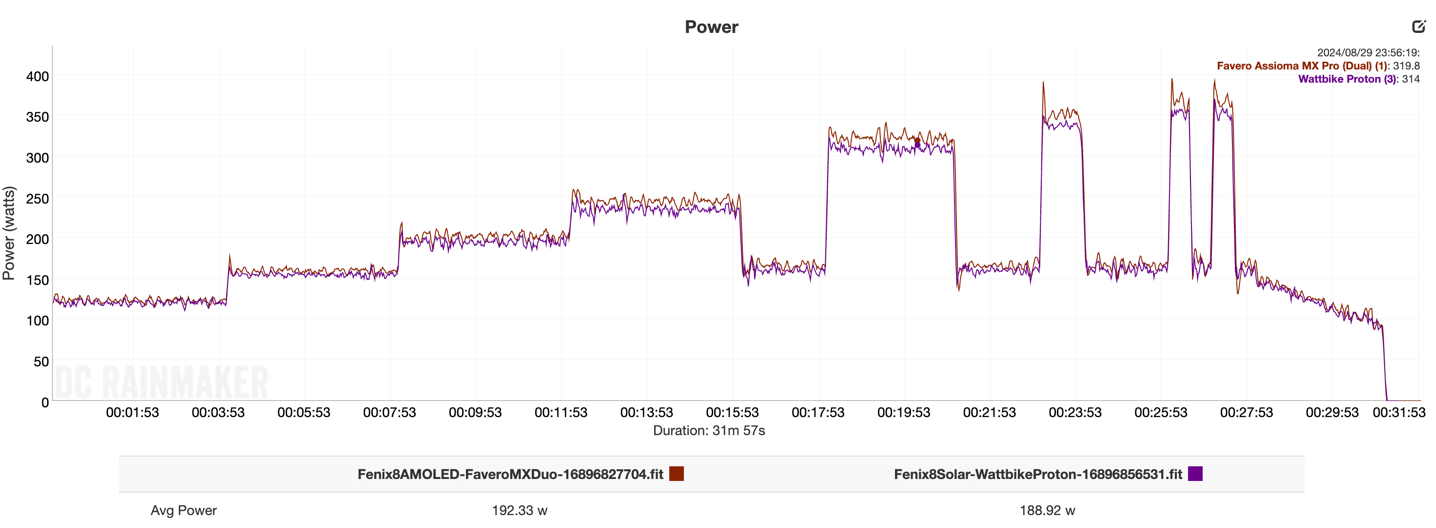
As you can see, the two units tracked each other in terms of the ups and downs, but there was a slight offset. This had me a bit perplexed, but I initially chalked it up to a settling ride. That said, in terms of ERG mode responsiveness, it was actually quite good, and also, much improved on the stability of ERG mode. As noted earlier, one of the big changes compared to the Wattbike ATOM resistance unit, was changing the gear ratio from an 18:1 to 13:1. This means that you can see *FAR* better stability of the ERG mode (no more wild swings). For example, like here, where the average +/- variations in the reported power are only about 8-10w above/below the set point. Though, I tend to see a bit more stability on the Wahoo KICKR Bike Shift (just slightly).
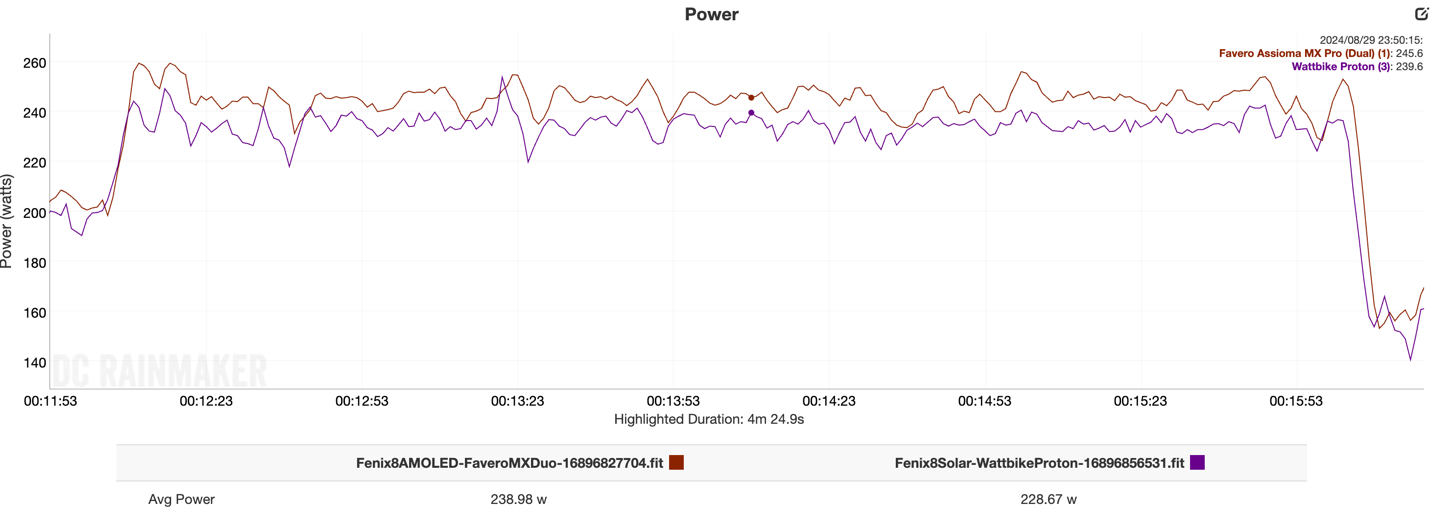
(Keep in mind this zoomed in graph with the scale, generally makes this look a wee bit crazier than reality.)
In any case, let’s look at another ERG mode workout. Again, you can see really solid stability here:
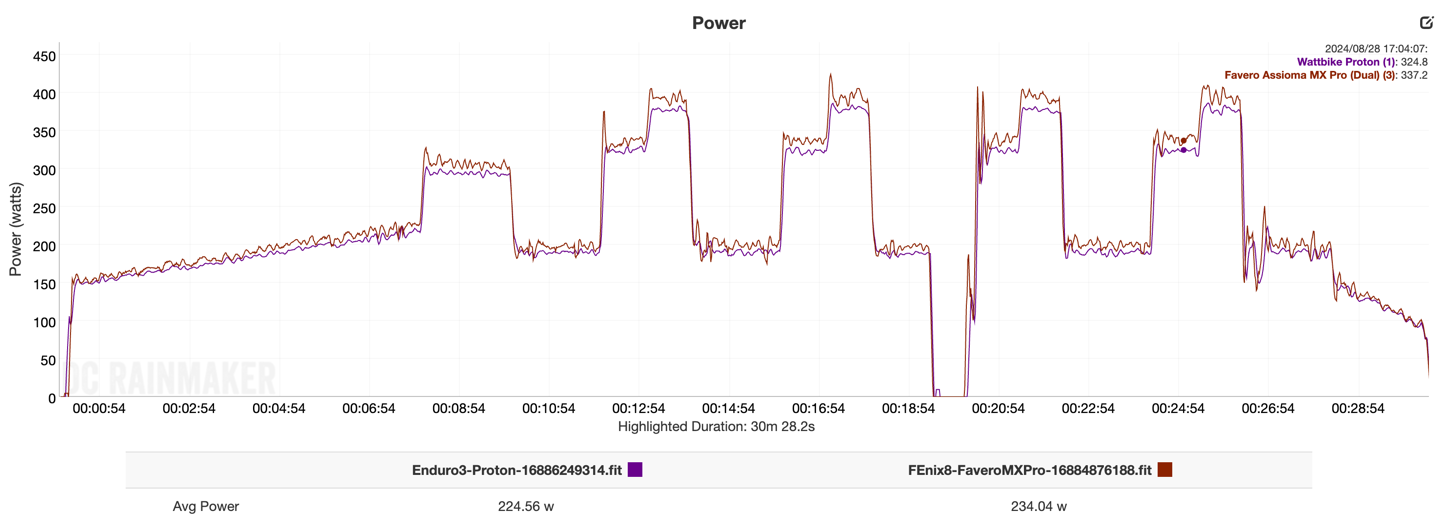
But also, that offset is still there, roughly 10-15 watts, which is too much. This was compared to the Favero Assioma Pro MX-2 power meter pedals. I have a few sets of them, but this particular set I’d seen a questionable (pre-Wattbike) general ride recently that gave me pause. Essentially one pedal seemed a bit offset (substantially high) compared to the other unit. Having imbalance is totally normal, but this offset on the Favero pedals was well beyond normal.
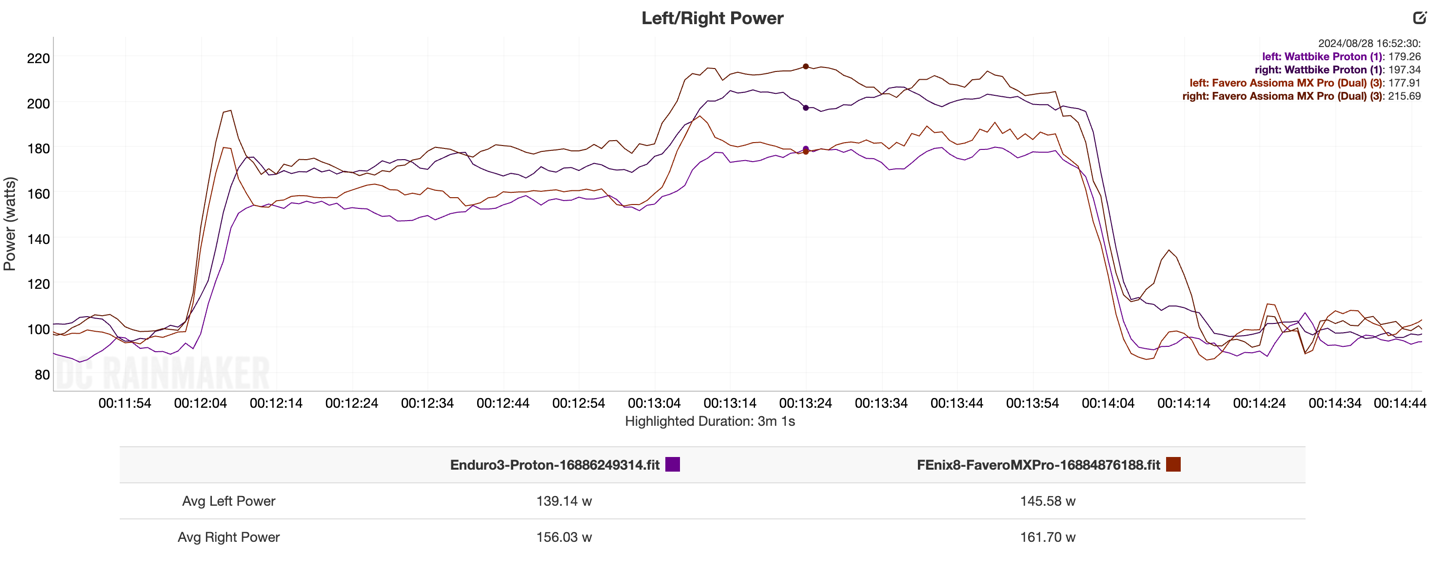
Thus, after this second ride with them, they got the boot. I removed them from the bike, and put them in the doghouse till I sort it out with Favero.
So instead, I grabbed his sibling, the Favero Assioma Duo-Shi pedals. These ones are in the good pile at the moment, and thus, I trust them. Stuck them on the bike, this time for a Zwift ride (non-ERG mode, with plenty of ups and downs), and boom, perfect alignment:
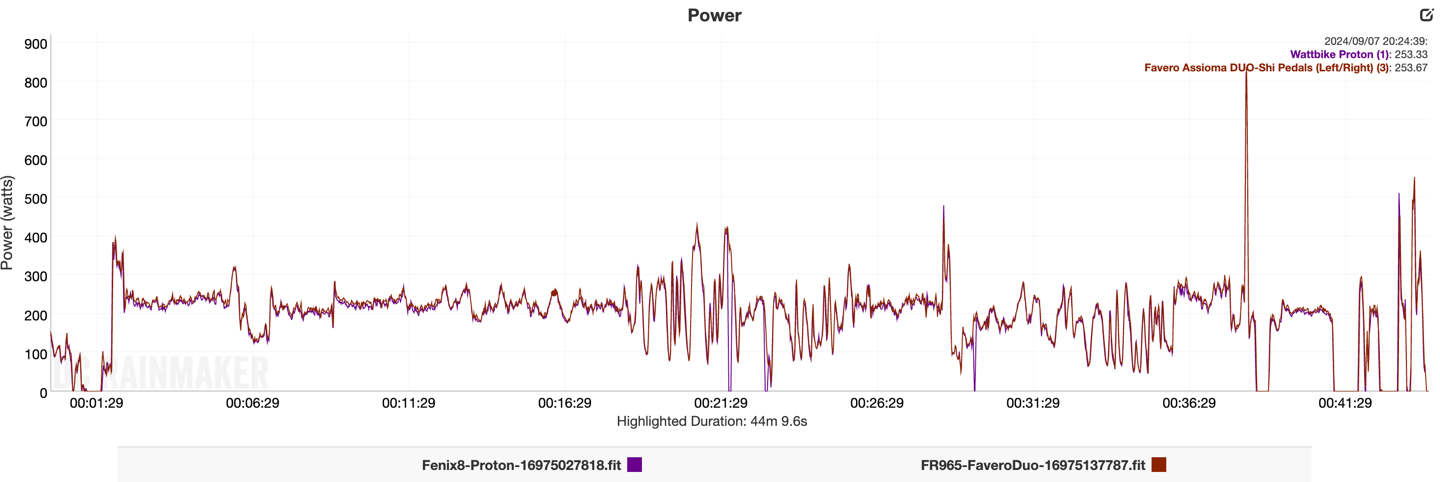
If I zoom into some sections, you can see the two units mirror each other very nicely:
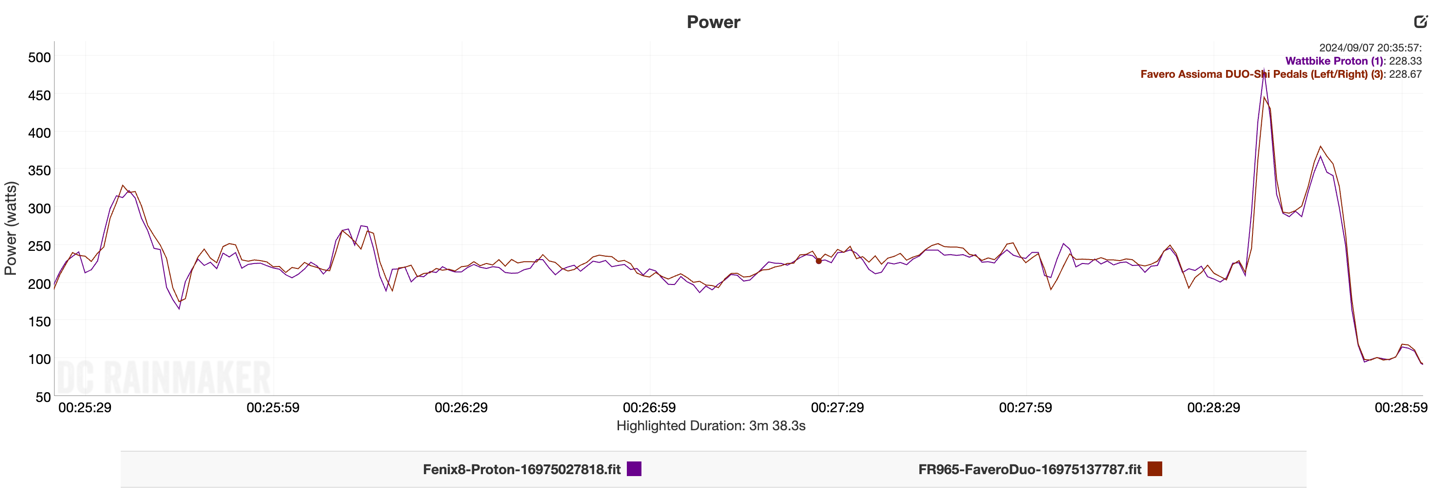
And even on this 900w sprint, there’s no meaningful variation here – they are very close:
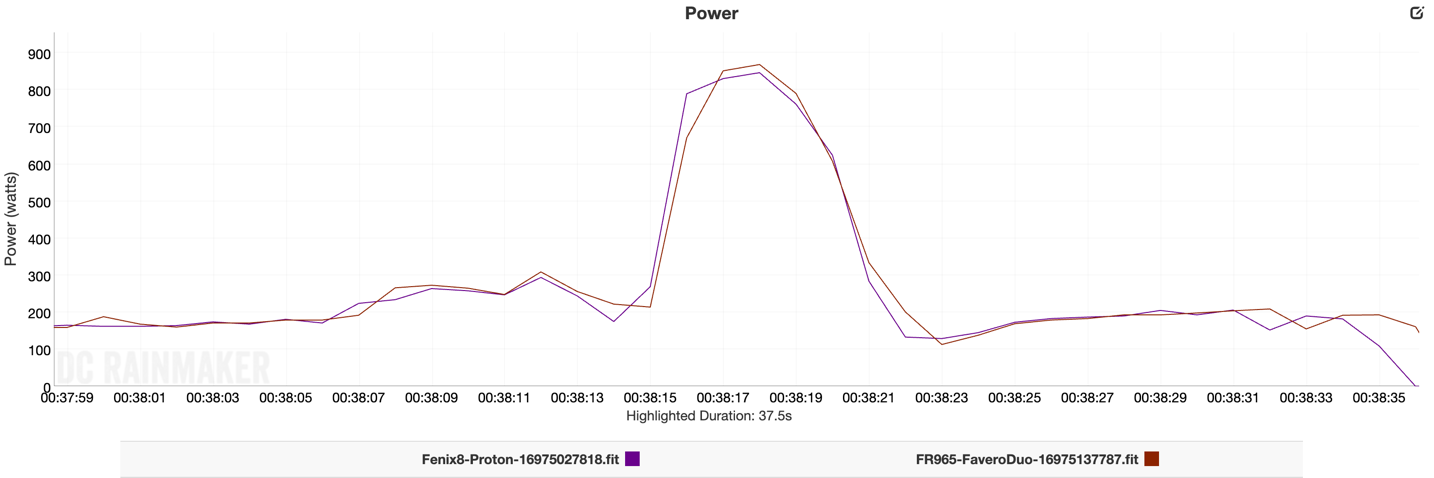
Super happy with that, and clearly indicates the other set of pedals need to go back to Favero to sort out. I’ve been traveling bunch the past few weeks, but I wanted to get these initial sets out now. And then I’ll add a few more in over the next few weeks, just to round-out the bunch. But accuracy wise looks good, as does stability.
And to be clear, straight-accuracy of the Wattbike ATOM previously was never an issue (was always good there), it was the ERG mode stability that was the standout issue, and that appears resolved at this point in my testing.
(Note: All of the charts in these accuracy sections were created using the DCR Analyzer tool. It allows you to compare power meters/trainers, heart rate, cadence, speed/pace, GPS tracks, and plenty more. You can use it as well, more details here.)
Summary:
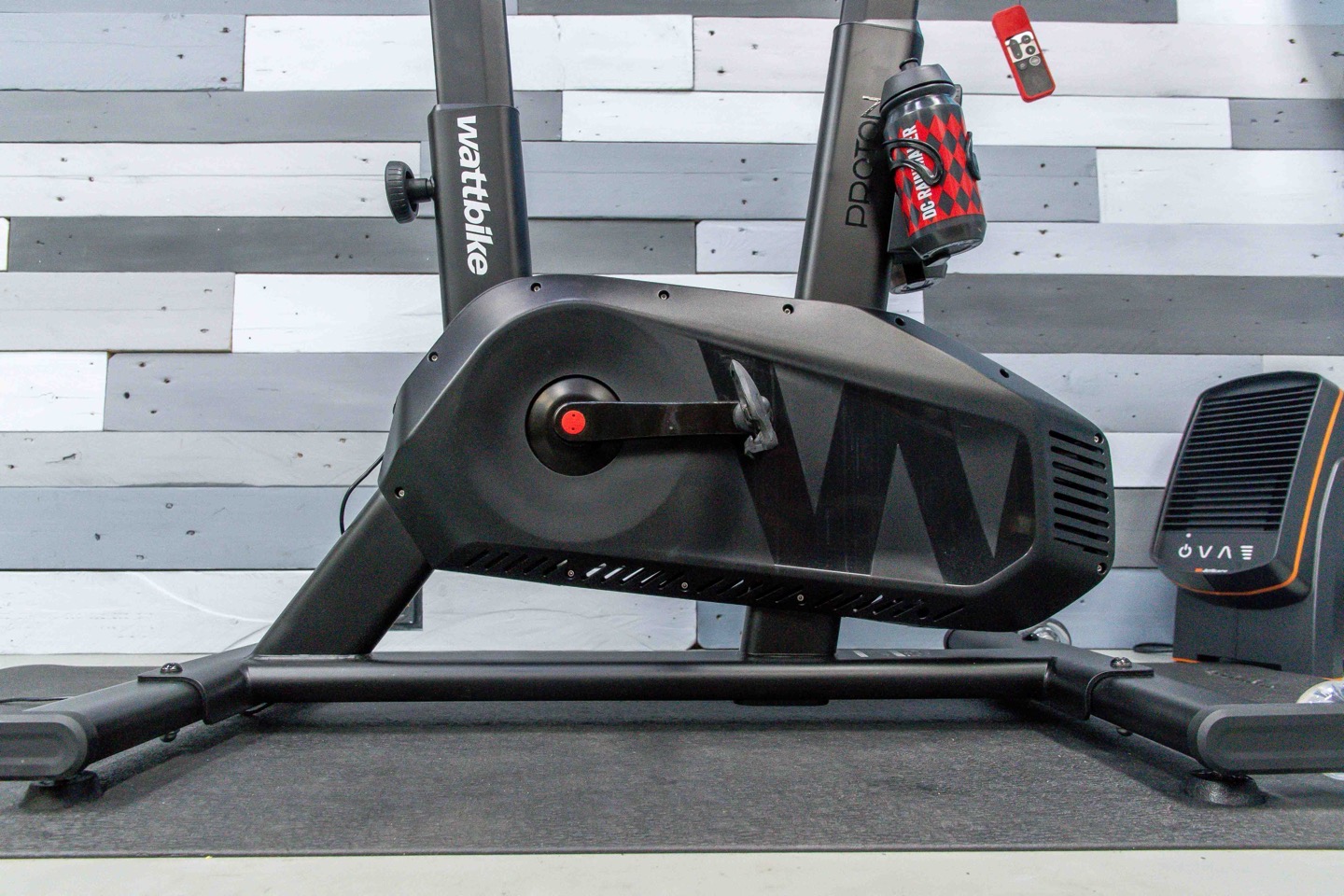
Wattbike themselves is very clear that the Wattbike Proton is designed more as a mass market bike, yet in many ways, setting looks (and aerobars) aside, from a technical standpoint, there’s virtually no difference to an ATOM. Sure, there’s the 1,800w vs 2,500w maximum difference in peak power resistance, but again, very very few riders are clearing 1,800w on a sprint. Thus, I don’t think that’s all the meaningful. And honestly, for most of those same riders, the much improved ERG mode handling for all riders is a far bigger deal than the sprint limitation for a few riders.
The appeal to a bike like this is adjustably and fit. If you were to compare it to the less expensive Zwift Ride setup, this unquestionably has more adjustability to fit different riders. Of course, it also has less direct Zwift game control integration, though you can solve most of that via Zwift Play buttons. Instead, it’s actually a comparison to the Wahoo KICKR SHIFT that’s more appropriate, especially after last week’s pricing adjustments the now put the KICKR SHIFT at the same USD pricing ($2,499) as the Wattbike Proton will sell at. Though, the UK pricing at £2,199 is of course £300 more than the Proton, likely giving some pause. Certainly, the KICKR SHIFT has more tech in it, but again, the Wattbike has more mass market appeal, especially with the wider range of included/free app workouts and training plans in the Wattbike Hub.
All of which then gets to the min competitor here, the other P word: Peloton. While it’s easy to say this is an Apples to Apples comparison, it’s kinda more like Apples to Pears. Peloton as product is as much about the hardware as it is the entire app and instructor ecosystem. To some, those instructors become the best part of the platform. And of course, you can use a Wattbike Proton with the Peloton App on an tablet/etc, but it won’t quite be the same experience (due to Peloton not connecting to 3rd party power meters). But equally, there’s just as many people that very much don’t want that instructor aspect. And Wattbike delivers a very solid bike for them in Proton, with the ability to use every other app on the market with true integration.
As always, it just depends on what you want. But either way, the Proton is a solid offering in that space at a reasonable price tag compared to their competitors.
With that, thanks for reading!

0 Commentaires